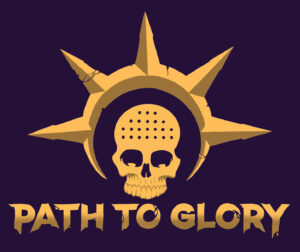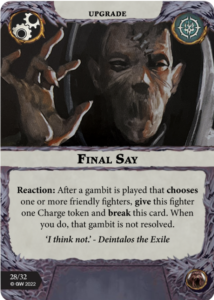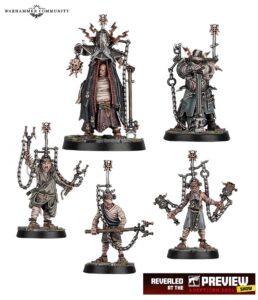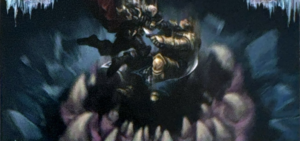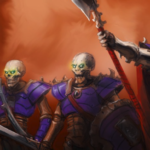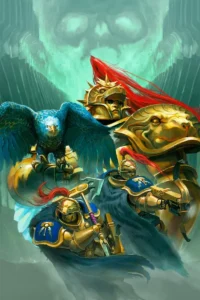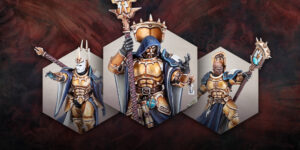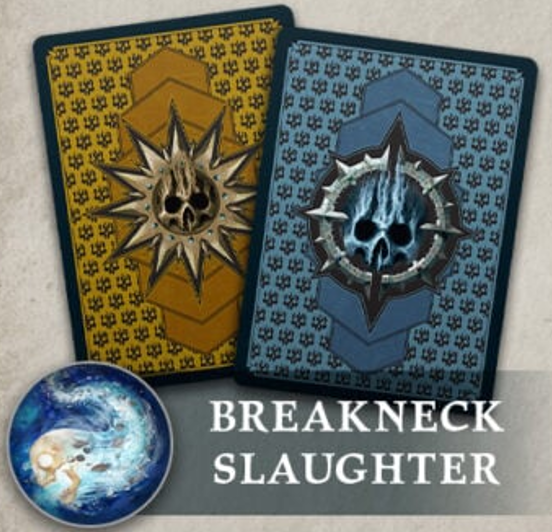
Intro
Dipping into the Rivals decks, we have Breakneck Slaughter, which was again promised to us as an aggro deck and this time definitely delivered on that promise. Even with a plot card, I’m pretty excited for this one, they packed some pretty interesting mechanics in here. With some of the cards in here, I’m actually pretty glad there’s a plot card on this one. There are some cards in here that would be pretty bananas in the wider universal pool. While I still don’t love the plot card as the stopgap here rather than just the overall design of the universal pool, the fact that we now have a nice mix of plot and non-plot decks makes it more tolerable. Anyway, I’m excited to talk about this one, let’s get into it!
Plot Card
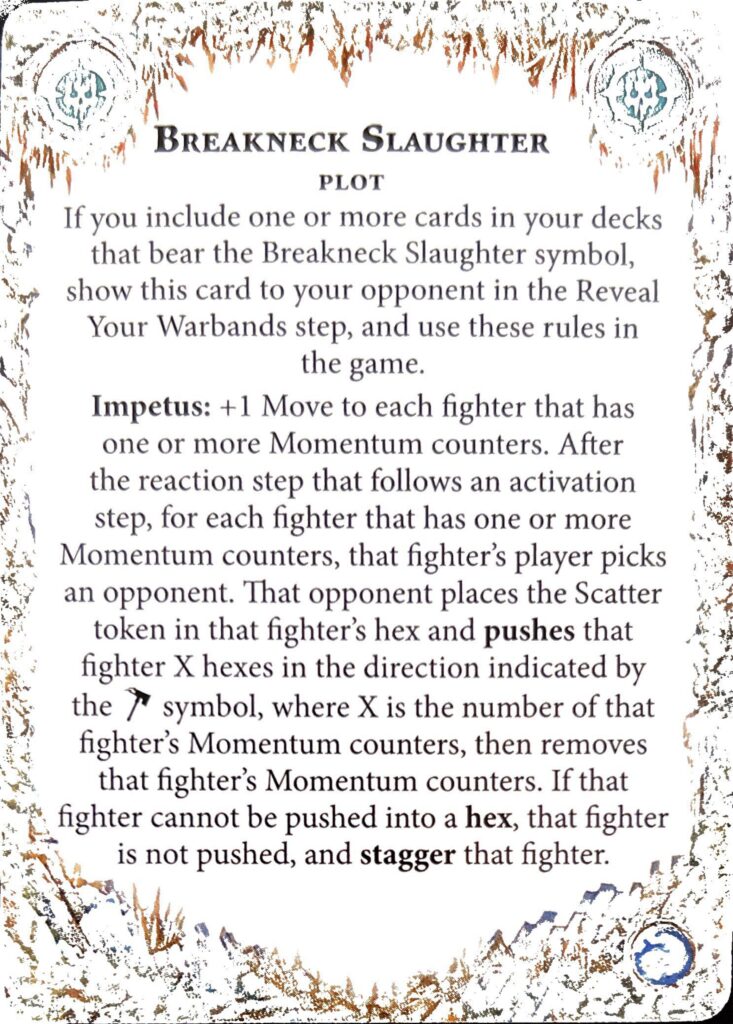
The plot card for the deck brings in the Impetus rule, which interacts with the Momentum counters the cards in the set give out. Any fighter with one or more counters has +1 Move and, after the reaction step following an activation, the opponent (of the fighter with the token) may push them in a straight line a number of hexes equal to the number of momentum counters that fighter has, staggering them if they ever get to a point where they cannot be pushed further. That is a mouthful, but also holy moly that is a wild plot. I assume the idea was to simulate people sliding around on the ice, which is a really cool concept for a deck. In implementation, this is going to be wild on the table. When I first read the card, I thought it was only after the fighter with the tokens activated, but it’s after any activation. You can slap a “cannot be pushed” effect on them to prevent the bouncing around, but just keep in mind you will be paying for it with a stagger token (although that is definitely the better trade). What is even more interesting is deliberately handing them to enemy fighters (which this deck allows you to do). I would be remiss not to mention my old friend [![]() Beastcaller]
Beastcaller]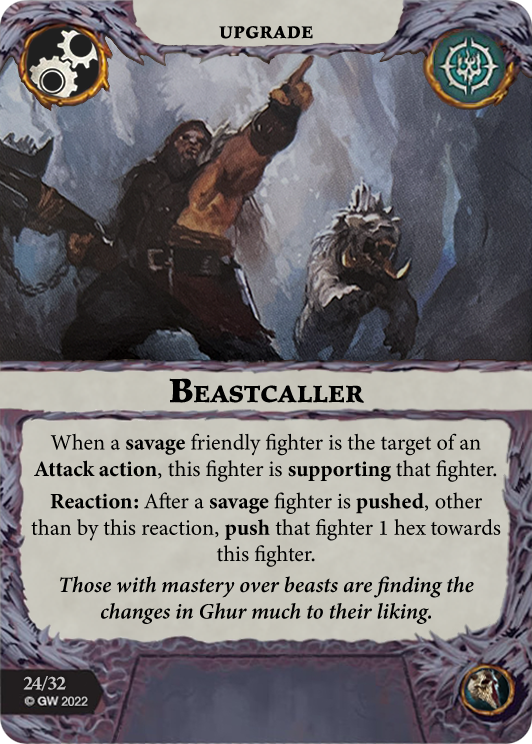 again to manipulate the push functionality of this deck! [
again to manipulate the push functionality of this deck! [![]() Mirror Move]
Mirror Move]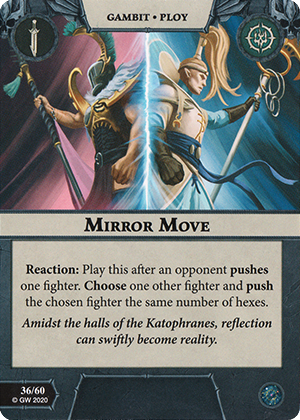 also deserves a shout out as basically an autotake if you are leaning into the counters. The idea of leaning into aggro/control hybrids with this sounds incredible, I think it’s going to be total chaos, but I’m interested to see how this plays on the table.
also deserves a shout out as basically an autotake if you are leaning into the counters. The idea of leaning into aggro/control hybrids with this sounds incredible, I think it’s going to be total chaos, but I’m interested to see how this plays on the table.
Objectives
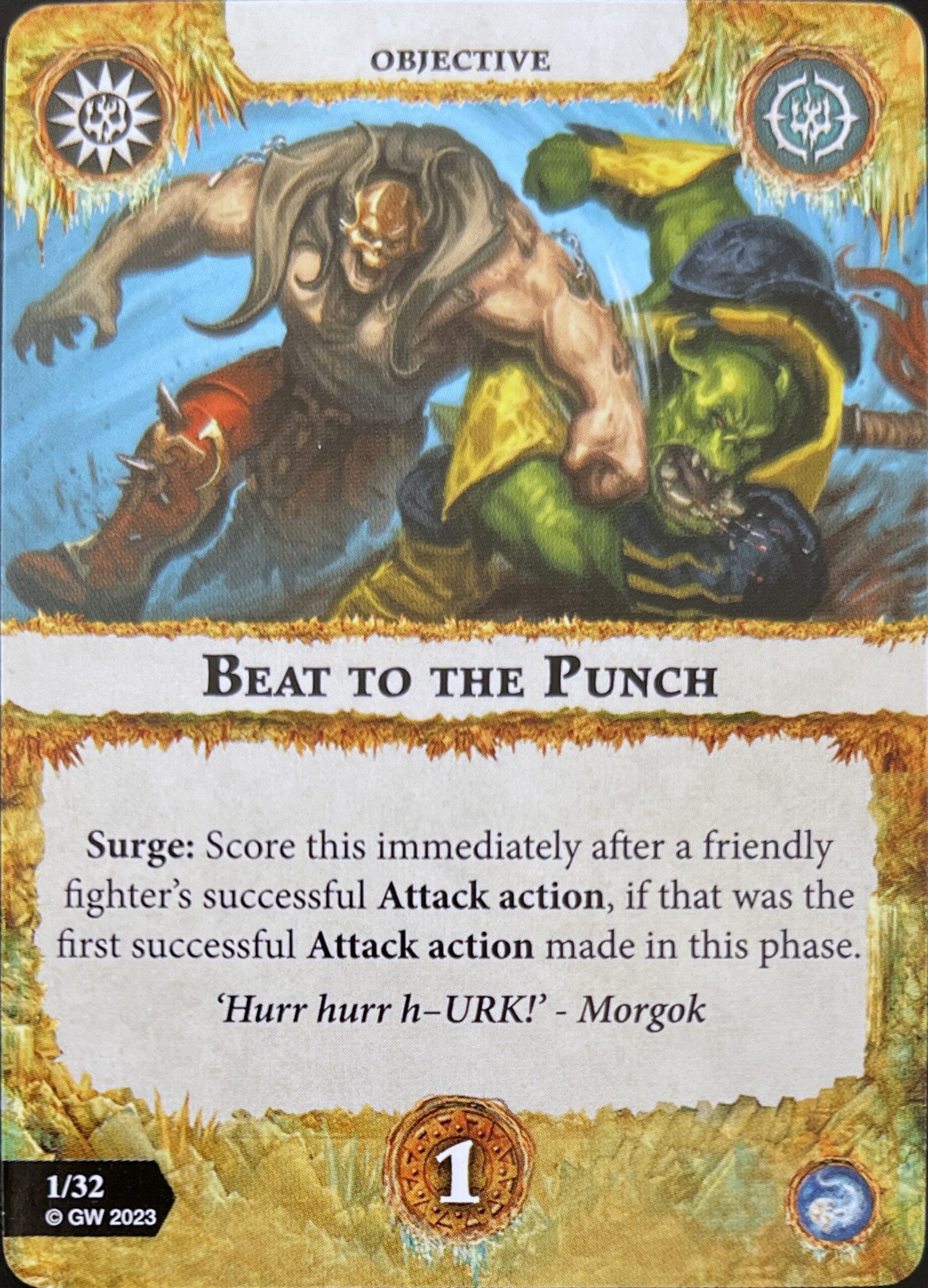
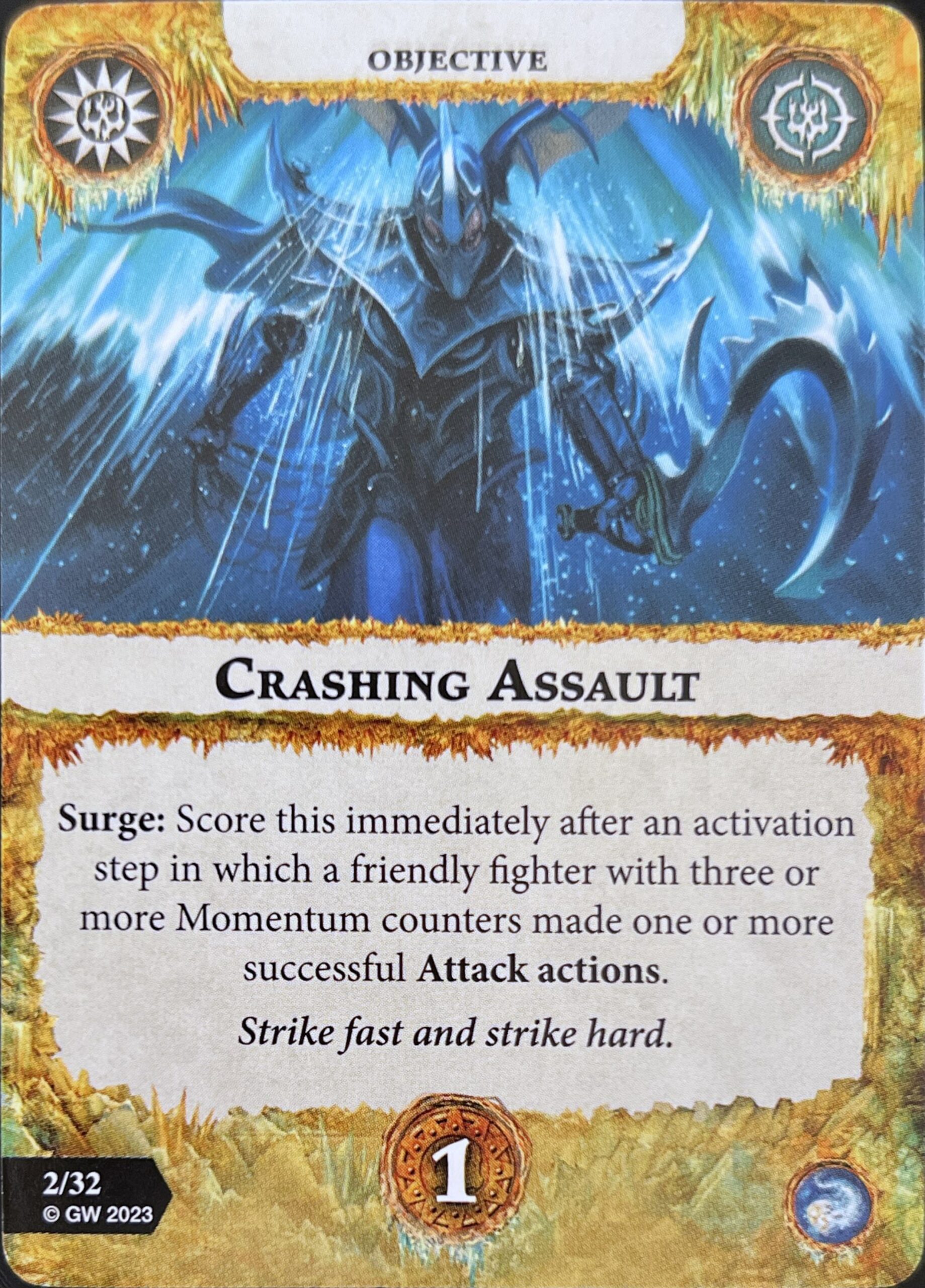
Our first objective is Beat to the Punch, a surge scored for making the first successful attack action of the phase. The most directly comparable card here would probably be [![]() Strong Start]
Strong Start]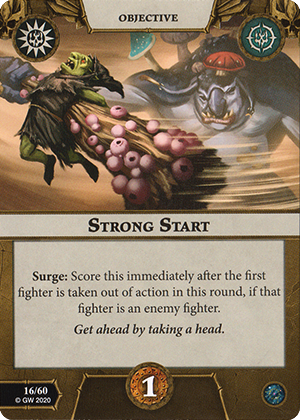 , although I think you actually take it on the opposite types of warbands. Where [
, although I think you actually take it on the opposite types of warbands. Where [![]() Strong Start]
Strong Start] typically favored bulkier elite warbands, you could be (and should be aiming to) score this surge in the very first activation of a round, which is often ceded by those elite warbands to warbands with higher fighter counts. Aggro hordes like Reapers could definitely make use of this card, but it does run into the same pitfalls as its counterpart. Primarily, what happens when you draw into it after the first successful attack of the round has already been made? The danger of this being the case, or your opponent just happening to beat you to the punch, bricks your hand pretty hard. In the end, I think this makes it a bit too much of a risk to take.
typically favored bulkier elite warbands, you could be (and should be aiming to) score this surge in the very first activation of a round, which is often ceded by those elite warbands to warbands with higher fighter counts. Aggro hordes like Reapers could definitely make use of this card, but it does run into the same pitfalls as its counterpart. Primarily, what happens when you draw into it after the first successful attack of the round has already been made? The danger of this being the case, or your opponent just happening to beat you to the punch, bricks your hand pretty hard. In the end, I think this makes it a bit too much of a risk to take.
Power Ceiling: 2, Consistency: 1, Universality: 2
Next up is Crashing Assault, which scores if a friendly fighter with three or more momentum counters makes a successful attack action. This one is quite a gamble. Not only will it likely take the effect of multiple power cards to amass the required counters, but you are leaving yourself vulnerable to a massive 3+ hex push if you have no way to redistribute those counters. Furthermore, if you miss, you’ve put a lot of eggs into a basket that may be unlikely to get off any more attacks with that fighter as they get pushed into oblivion by your opponent.
Power Ceiling: 2, Consistency: 1, Universality: 2
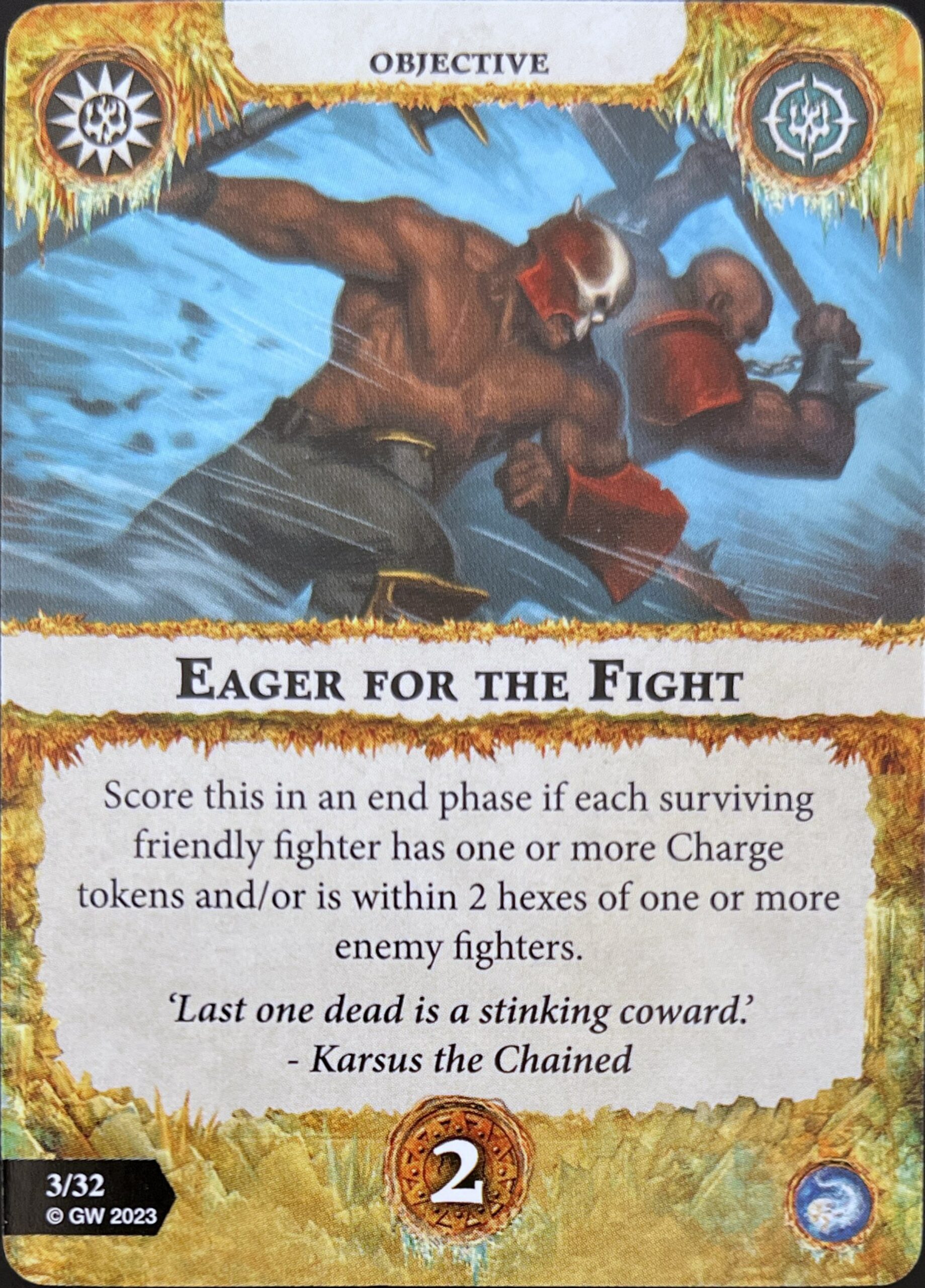
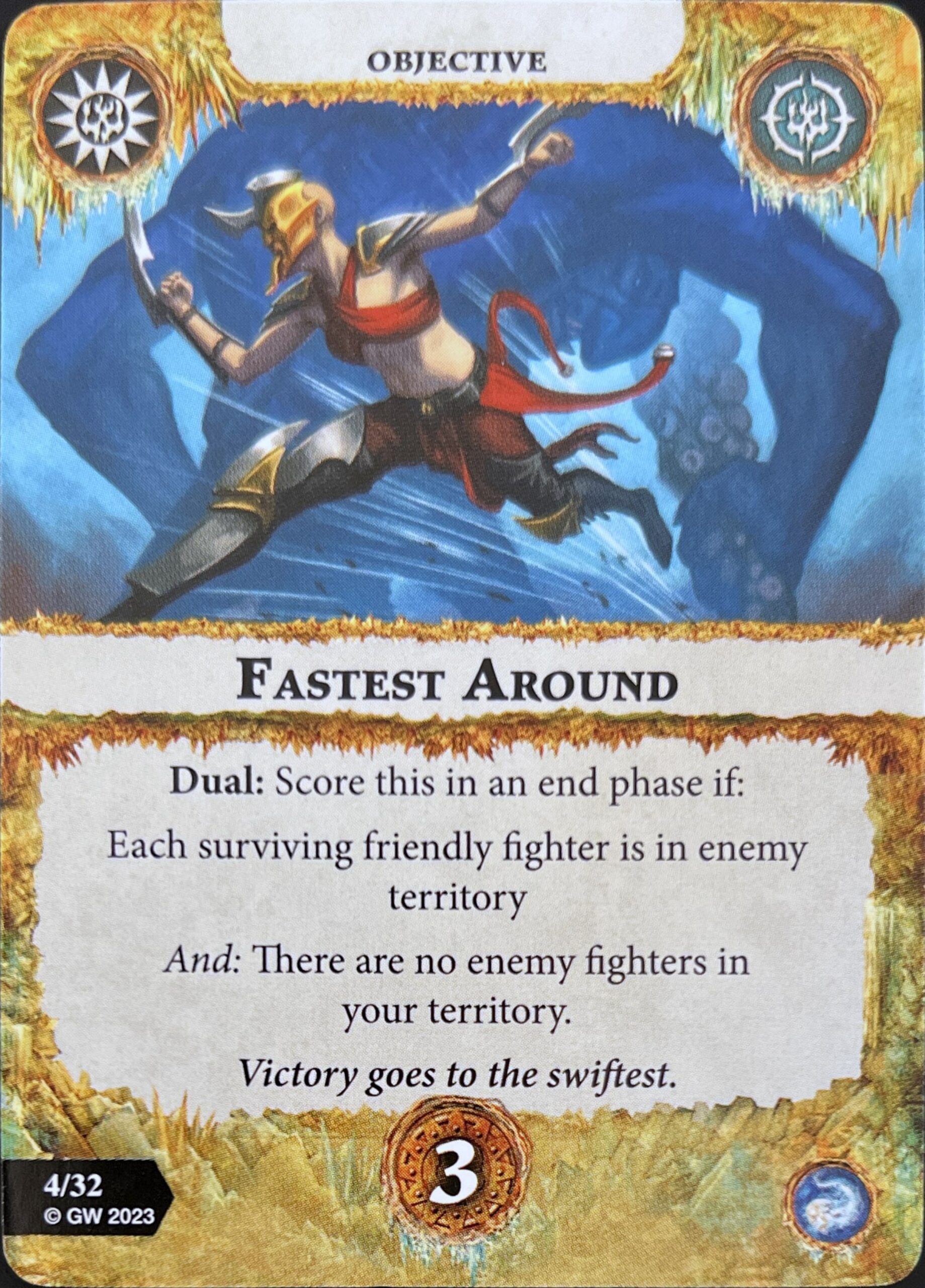
Next up is Eager for the Fight, scoring for 2 glory in the end phase if each friendly fighter has a Charge token and/or is within 2 hexes of an enemy fighter. This is exactly the kind of aggro objective you’d want, especially in a 4-fighter or less warband. This is just straight-up a better version of [![]() Unafraid]
Unafraid]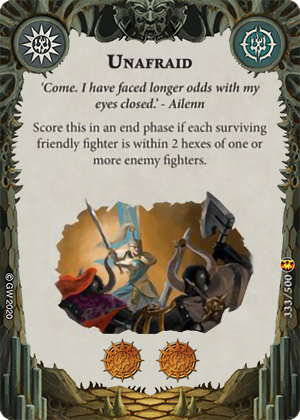 , which was already reasonably solid. Like I said earlier, I think this is the kind of card that benefits from the plot lock because I think it would be all over the place. Even something like Stormcoven, which wouldn’t want this deck for much else, could just abuse their range to charge out for an easy 2 glory, but at least now anyone who wants to do so needs to sacrifice their plot slot. Additionally, the more fighters you shed over the course of the game, the fewer you need to worry about meeting either condition.
, which was already reasonably solid. Like I said earlier, I think this is the kind of card that benefits from the plot lock because I think it would be all over the place. Even something like Stormcoven, which wouldn’t want this deck for much else, could just abuse their range to charge out for an easy 2 glory, but at least now anyone who wants to do so needs to sacrifice their plot slot. Additionally, the more fighters you shed over the course of the game, the fewer you need to worry about meeting either condition.
Power Ceiling: 3, Consistency: 2, Universality: 3
Fastest Around is just a [![]() Hurricane Force]
Hurricane Force]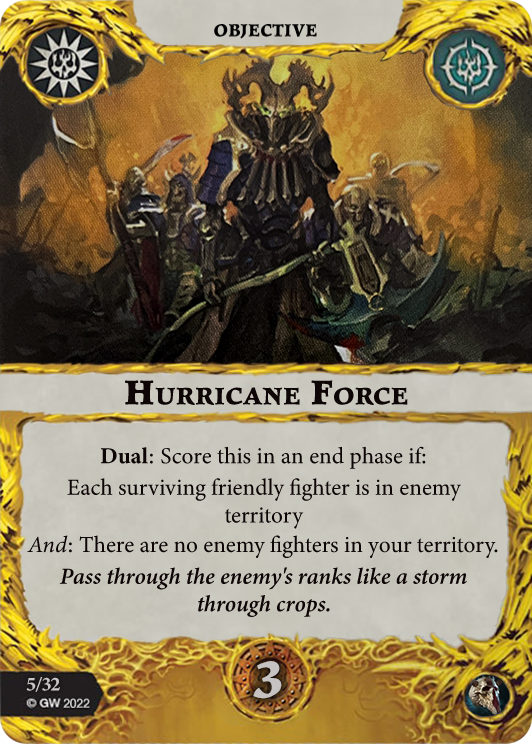 reprint, which I have to say is a bit disappointing to see so soon. I can appreciate that Rivals decks are being designed with the plot lock and Nemesis deckbuilding restrictions in mind, but I just am not a fan of seeing multiple universal copies of the same card in rotation at the same time. I will say that I have come around a bit on this objective for elite aggro warbands, as you have a lot of control over your positioning while also typically threatening your opponent enough that they won’t come to you. It is also a nice way to counterplay the passive Stormcoven type of play that has Championship in a stranglehold. Still, it is quite matchup dependent. You might get forced into it in Nemesis, but it presents something of a 50-50 every time your opponent reveals your warband choice.
reprint, which I have to say is a bit disappointing to see so soon. I can appreciate that Rivals decks are being designed with the plot lock and Nemesis deckbuilding restrictions in mind, but I just am not a fan of seeing multiple universal copies of the same card in rotation at the same time. I will say that I have come around a bit on this objective for elite aggro warbands, as you have a lot of control over your positioning while also typically threatening your opponent enough that they won’t come to you. It is also a nice way to counterplay the passive Stormcoven type of play that has Championship in a stranglehold. Still, it is quite matchup dependent. You might get forced into it in Nemesis, but it presents something of a 50-50 every time your opponent reveals your warband choice.
Power Ceiling: 3, Consistency: 1, Universality: 2
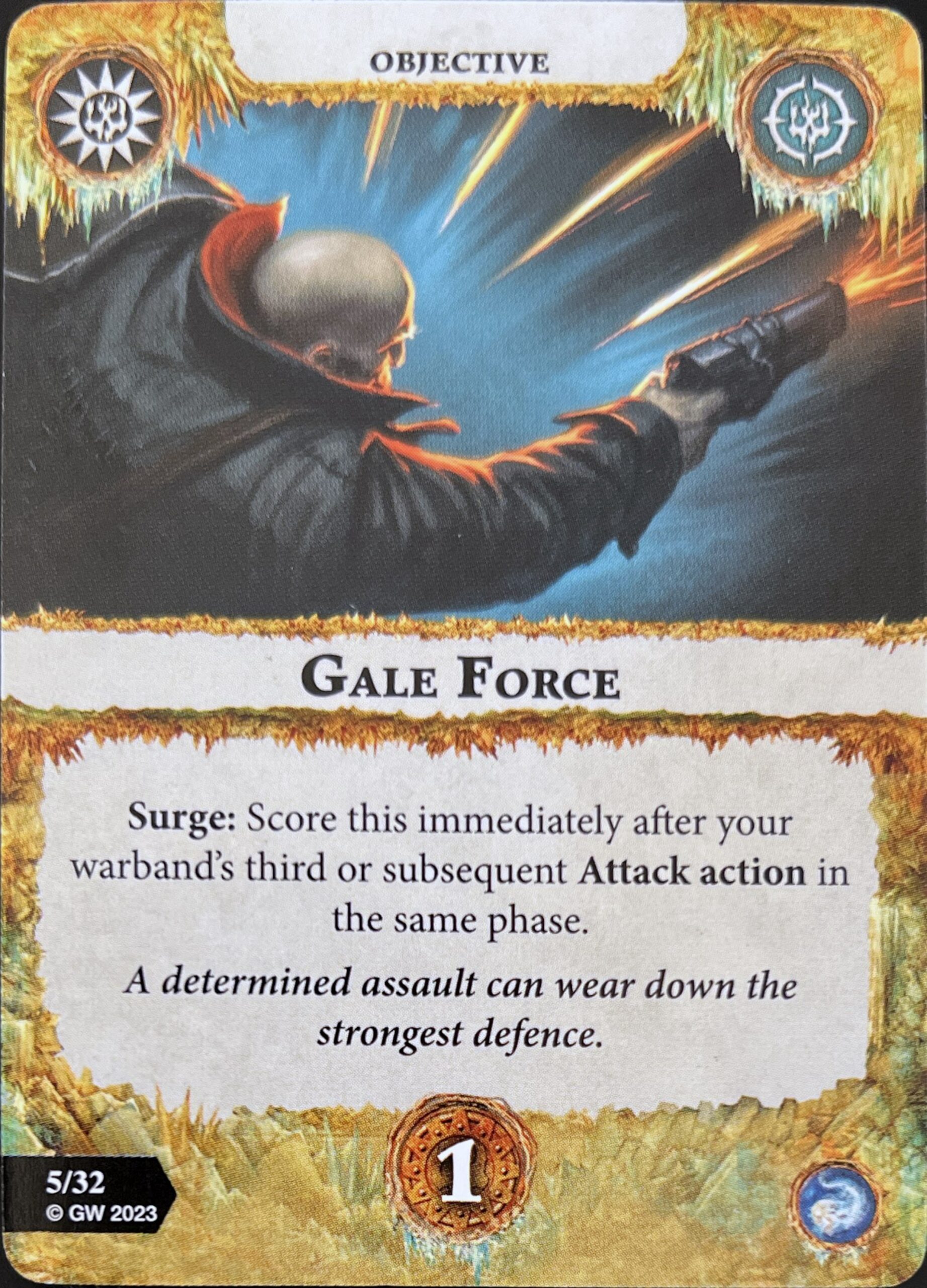
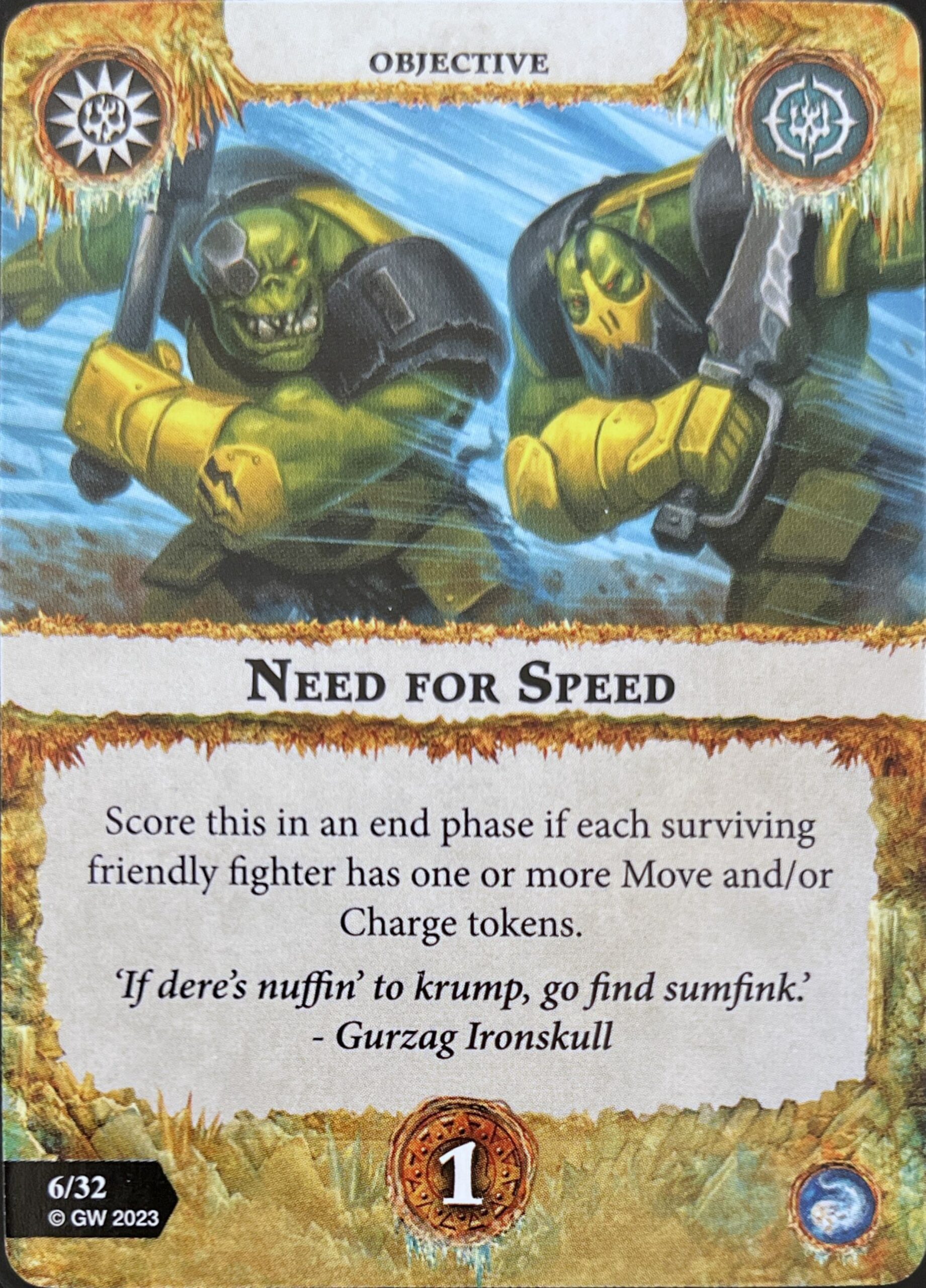
Gale Force is our next surge, scoring when you’ve made your third or subsequent attack in a round. This is another one of those cards that you’d definitely see in most or every deck if it weren’t locked into a plot card. While you’re not scoring this immediately at the start of a round, it is practically inevitable in a lot of cases. Warbands that have range are able to make sure they’re tossing out attacks, while many that don’t have the speed to make those attacks anyway. Exiled Dead can even pull this off in a single activation! Super good card.
Power Ceiling: 3, Consistency: 3, Universality: 3
Speaking of reprints, Need for Speed is just [![]() Move or Die]
Move or Die]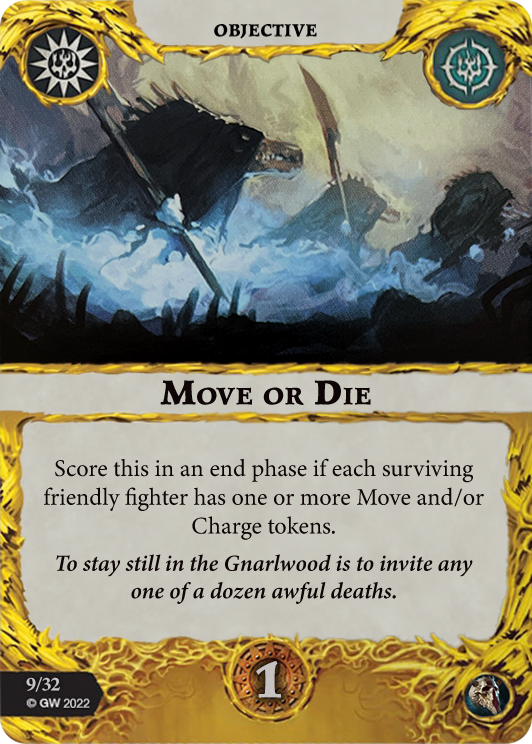 again. Still a very solid objective of course, but again I’d like to see more distinct cards in the same rotation cycle.
again. Still a very solid objective of course, but again I’d like to see more distinct cards in the same rotation cycle.
Power Ceiling: 2, Consistency: 3, Universality: 2

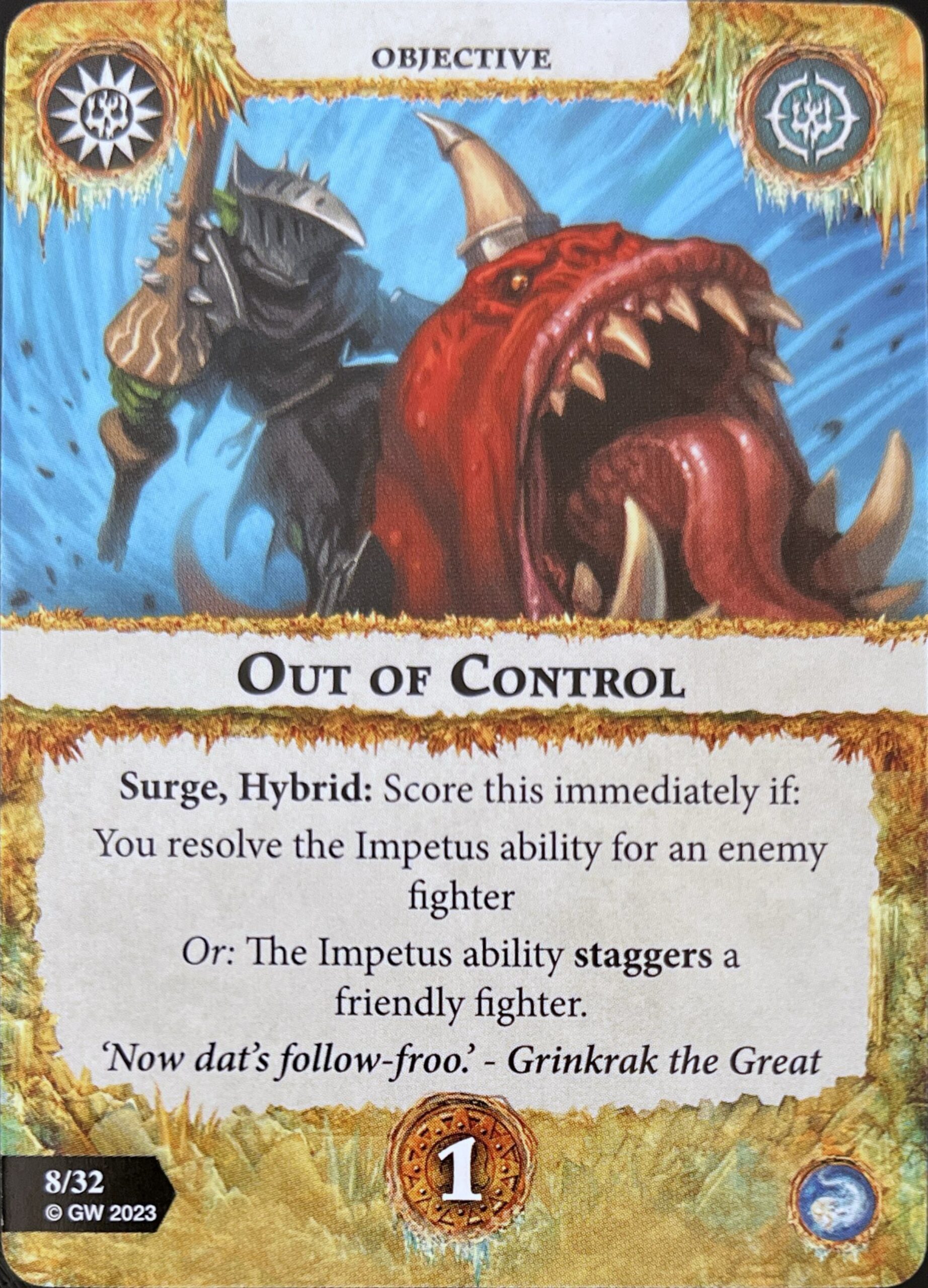
Not Fast Enough is a kill surge for taking out an enemy fighter with one or more Move/Charge tokens. This is a bit along the lines of [![]() Regal Riposte]
Regal Riposte]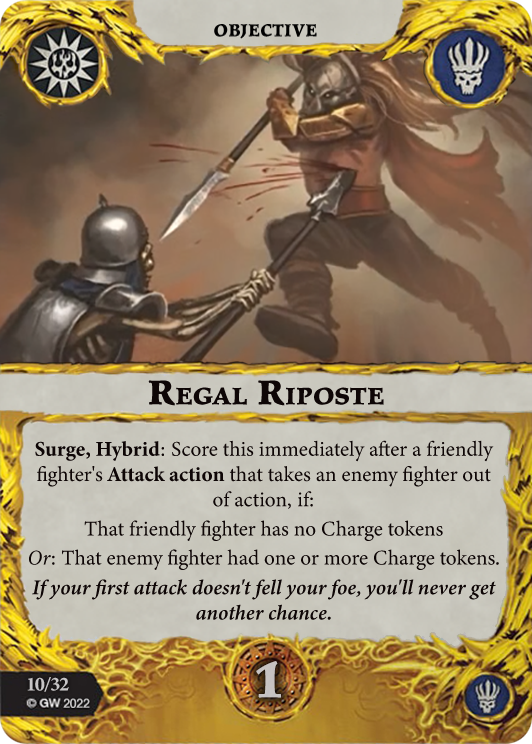 . As far as kill surges go, that’s not too bad. While you generally prefer to go after targets who’ve not yet activated, it is generally easiest to swarm and kill the ones who’ve charged out. There are even some warbands capable of spamming out move tokens upon several fighters to increase your target pool here. Still, I think the universal pool has enough non-kill surges these days that you shouldn’t need this, and even in Nemesis, I would say it’s a bit borderline.
. As far as kill surges go, that’s not too bad. While you generally prefer to go after targets who’ve not yet activated, it is generally easiest to swarm and kill the ones who’ve charged out. There are even some warbands capable of spamming out move tokens upon several fighters to increase your target pool here. Still, I think the universal pool has enough non-kill surges these days that you shouldn’t need this, and even in Nemesis, I would say it’s a bit borderline.
Power Ceiling: 1, Consistency: 2, Universality: 3
Out of Control is a surge for resolving the Impetus ability for an enemy fighter or one of your fighters being staggered by the ability. There are 4 ways to give Momentum counters to enemy fighters in the deck, which is not bad, but I do suspect the more common mode for scoring this one (outside of the mirror match) will be on the stagger condition. Slap a “cannot be pushed” card on one of your fighters with a counter, then pay the stagger for the score. I did mention the mirror, so I think it is worth calling out how trivial it ought to be there a la Surrendered Will in the VCT mirror. I think this deck will have some decent popularity among aggro warbands, so the combo of automatic in that matchup and still doable or even pretty easy in other matchups makes this a really attractive option, especially since you might not need to interact much to score it.
Power Ceiling: 3, Consistency: 2, Universality: 3
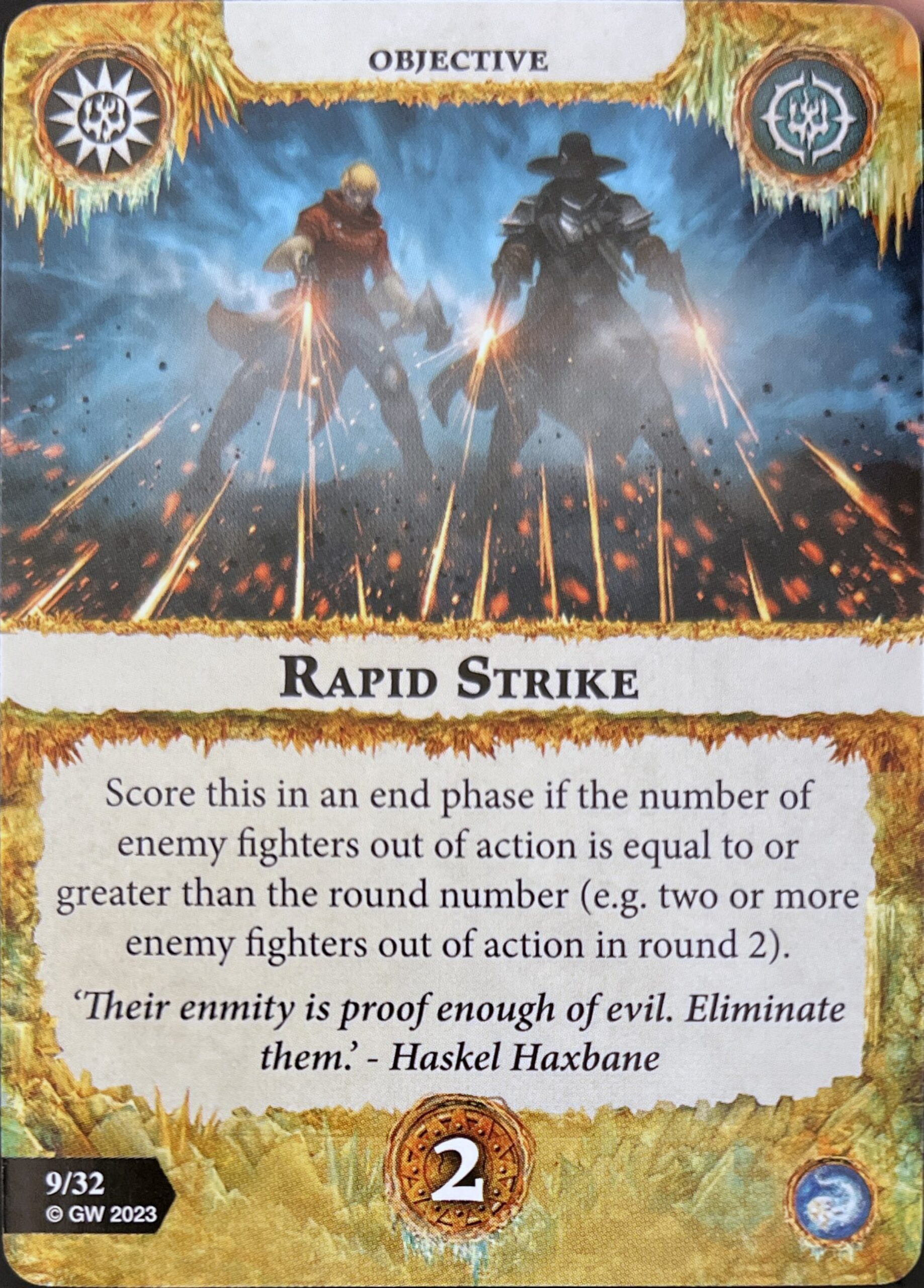
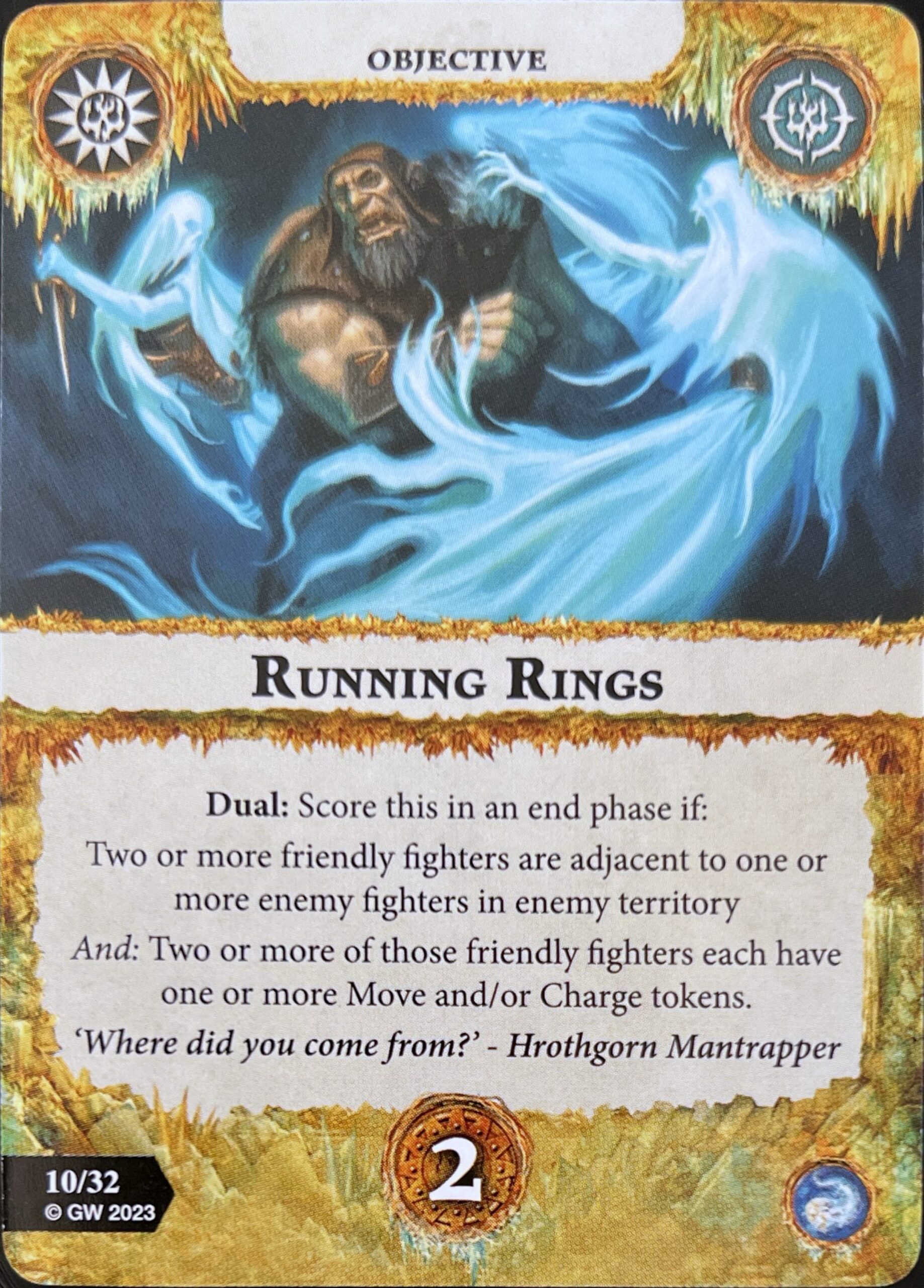
Next is Rapid Strike, scoring 2 glory in the end phase if there are a number of enemy fighters out of action equal to or greater than the round number. Even outside of the context of an aggro deck, this is phenomenal. You get even one kill in Round 1 and you score 2 glory. Two kills for 2 glory in Round 2 is even above-market value for a “two fighters out of action” and, worst case, three OOA for 2 glory is a card that has existed for a long time (although has not provided quite as much value at that stage). If you are a slower warband, there is some risk that a passive Stormcoven or something will be able to cluster up in the corner out of range, but at least the deck provides a lot of additional movement to set up those early charges.
Power Ceiling: 3, Consistency: 2, Universality: 3
Running Rings is another 2-glory end phase if two or more friendly fighters are adjacent to one or more enemy fighters in enemy territory and two or more of them have Move/Charge tokens. This is a bit like treating [![]() Impending Doom]
Impending Doom]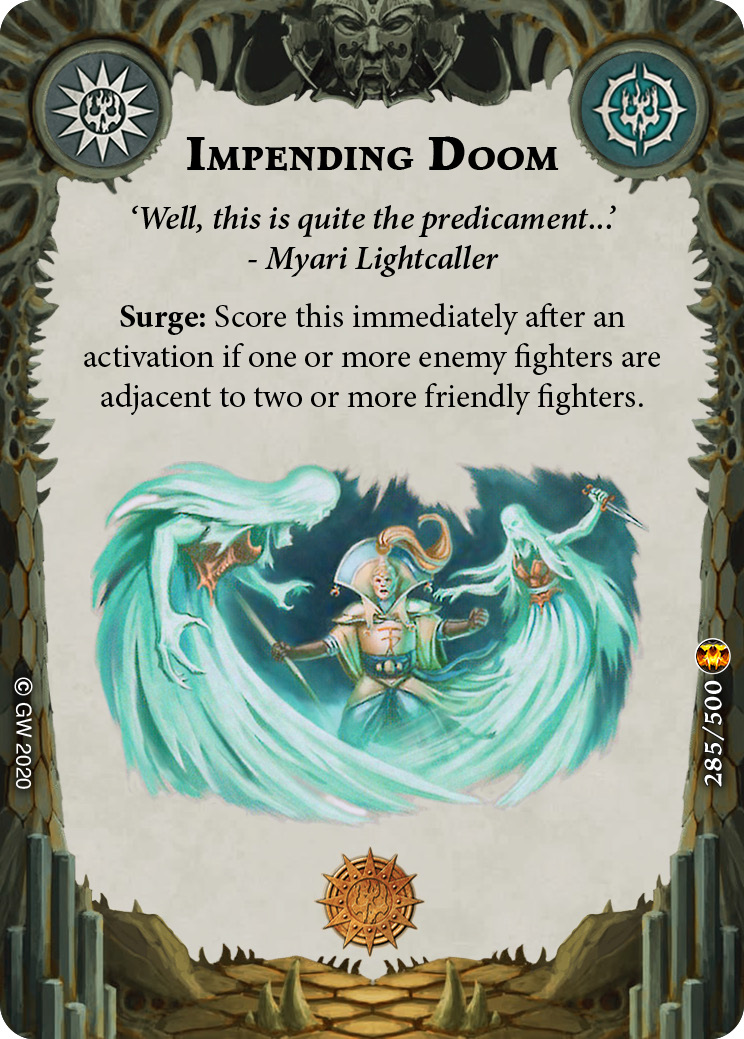 as an end phase card, although I think, based on the wording, you could score it even if your fighters are adjacent to different enemy fighters. While I like the idea of a big aggro score without needing to hit or kill things, there are a couple of hang-ups. Firstly, I’ve mentioned many times that I don’t love the idea of deliberately giving up adjacency in an end phase, as you set yourself up for easy counterpunches. On top of that, you’re setting up a positional requirement of being in enemy territory which, while it might be your plan anyway, does not necessarily synergize with what your opponent is trying to do. If you expect to see a lot of more passive matchups, I could see teching this into your aggro deck, but there’s a lot of conditions to be satisfied here that push its value down a bit for me.
as an end phase card, although I think, based on the wording, you could score it even if your fighters are adjacent to different enemy fighters. While I like the idea of a big aggro score without needing to hit or kill things, there are a couple of hang-ups. Firstly, I’ve mentioned many times that I don’t love the idea of deliberately giving up adjacency in an end phase, as you set yourself up for easy counterpunches. On top of that, you’re setting up a positional requirement of being in enemy territory which, while it might be your plan anyway, does not necessarily synergize with what your opponent is trying to do. If you expect to see a lot of more passive matchups, I could see teching this into your aggro deck, but there’s a lot of conditions to be satisfied here that push its value down a bit for me.
Power Ceiling: 2, Consistency: 2, Universality: 2
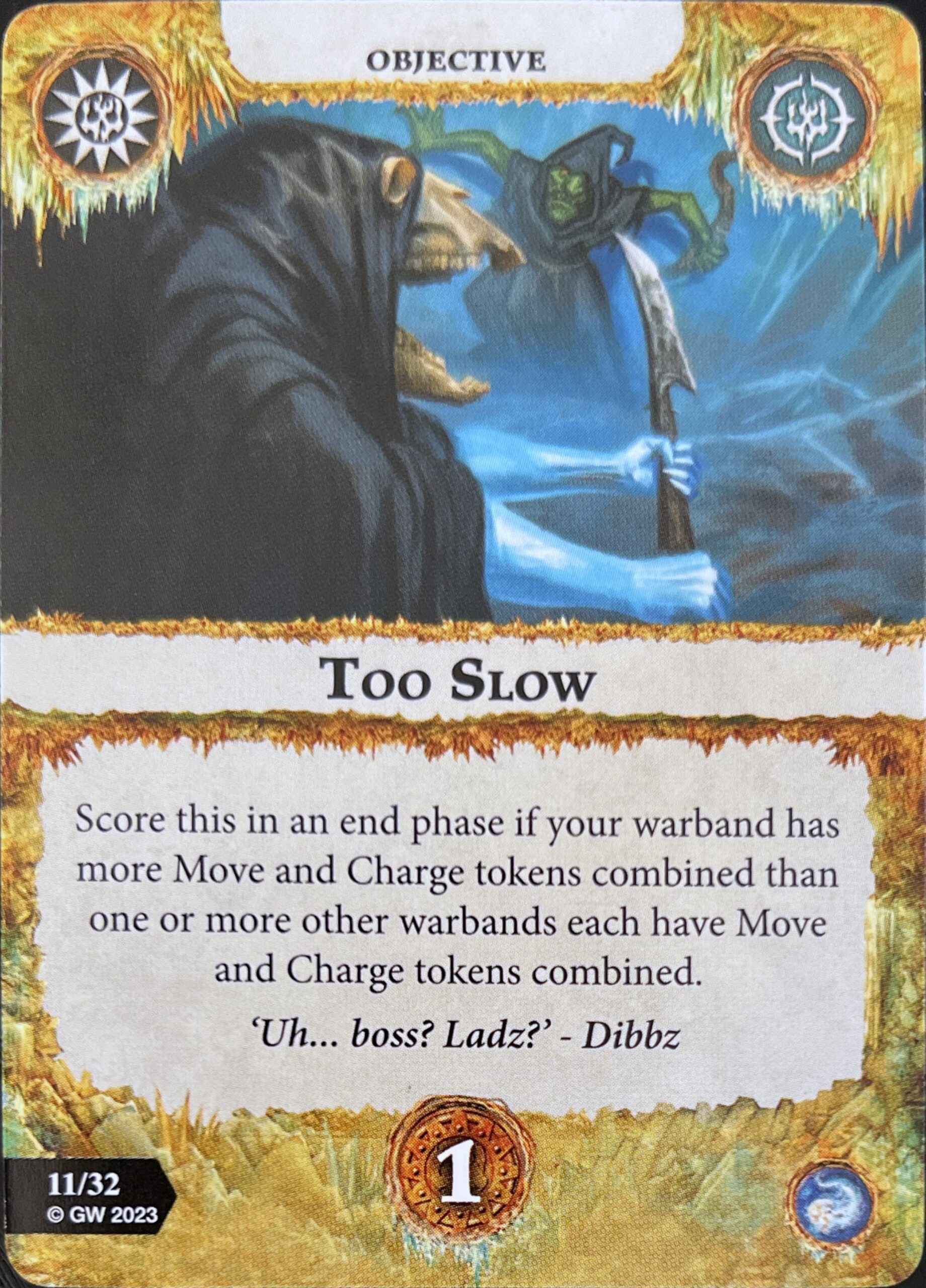
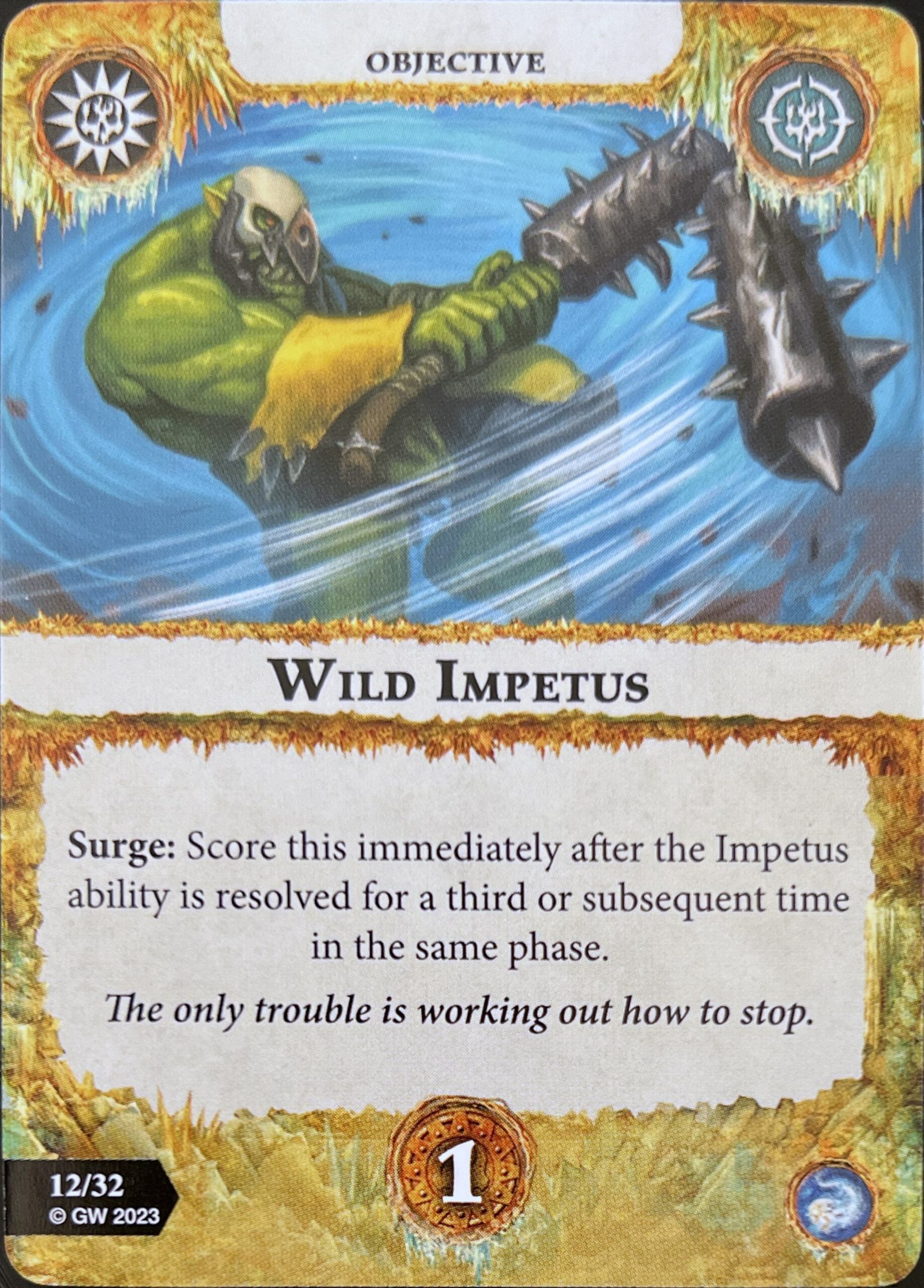
Too Slow is a 1-glory end phase for having more Move/Charge tokens than the opposing warband. You can see why maybe they wouldn’t have wanted you to combine this with Voidcursed Thralls. While I do prefer the option to take the “each of my fighters has a Move/Charge,” a number of horde warbands could make preferential use of this. Sepulchral Guard and Exiled Dead, for example, can spam multi-movements despite often not always moving all of your fighters. Interestingly, this is also an objective that brings Da Kunnin’ Krew into play since you can technically loop Move actions around Mannok forever if you have it set up correctly. Not sure how you would count that in terms of numbers, but maybe just saying each fighter in the shuffle has “infinite” tokens is enough. Overall, I think this falls under the umbrella of a lot of 1-glory end phases designed for horde warbands in that they generally need something to give them a higher glory ceiling or a more automatic condition if they are taking a 1-glory. Not bad by any means, but there are more dependable 1-glory scores to go for.
Power Ceiling: 1, Consistency: 2, Universality: 2
Our final objective is Wild Impetus, which scores for the resolution of the third or subsequent Impetus ability in the phase. As written, resolving the pushes is not optional. If you have fighters with Momentum counters, you pick your opponent and they push your fighters. No “may,” no “can,” they just have to do it. Assuming you’ve actually taken counter generation (of which there is a tremendous amount in the deck), you’re probably scoring this no later than the 4th activation of the round. Since the counters even have a significant effect of additional movement, in Championship (where you also have access to “cannot be pushed” tech) I could see popping some of those cards into your deck, especially if it means you’re going to be scoring such an easy and minimally interactive surge.
Power Ceiling: 3, Consistency: 2, Universality: 3
Our Favorites
- Mark: Eager for the Fight
- Aman: Rapid Strike
- Zach: Gale Force
- George: Eager for the Fight
Gambits
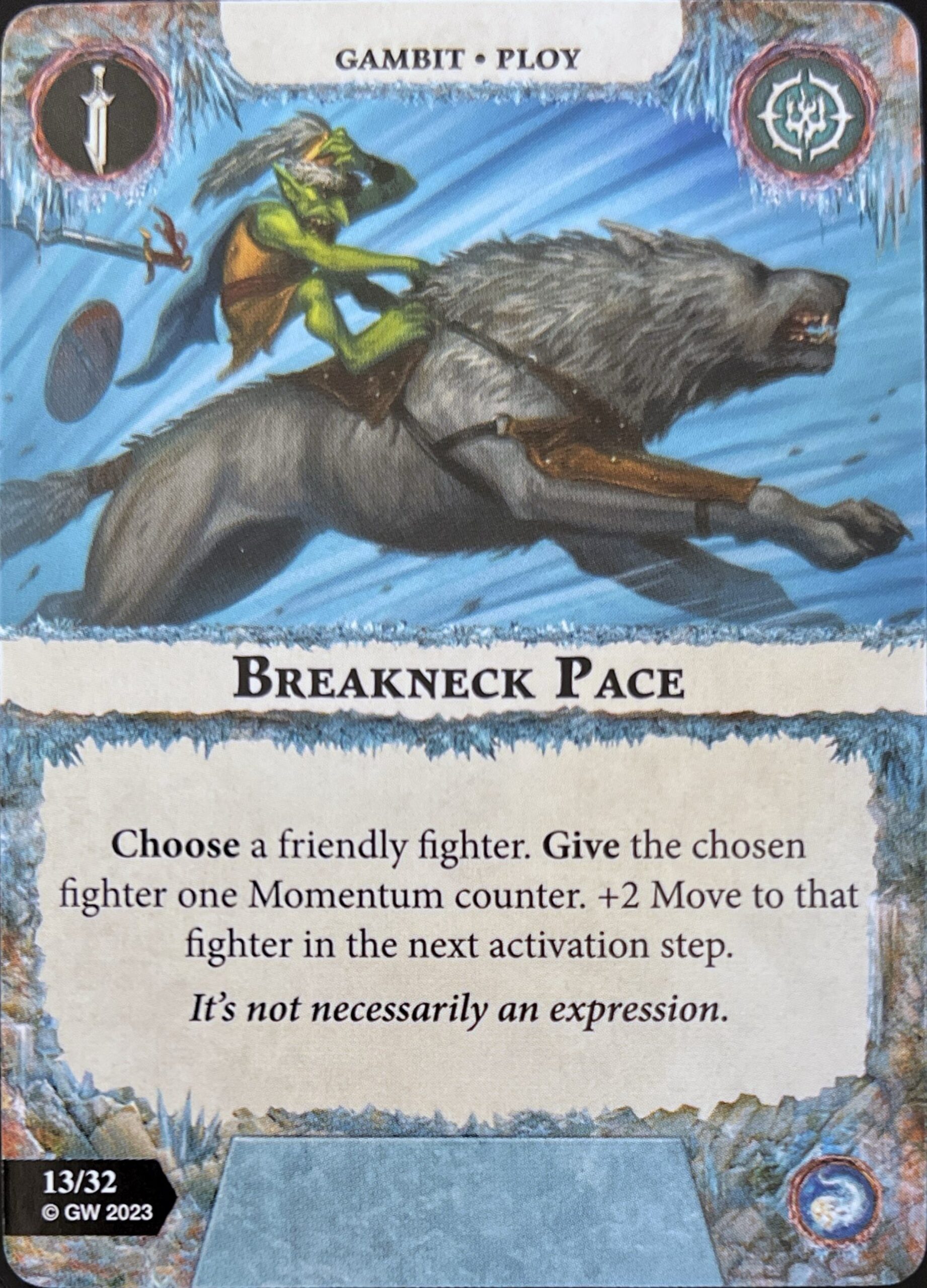
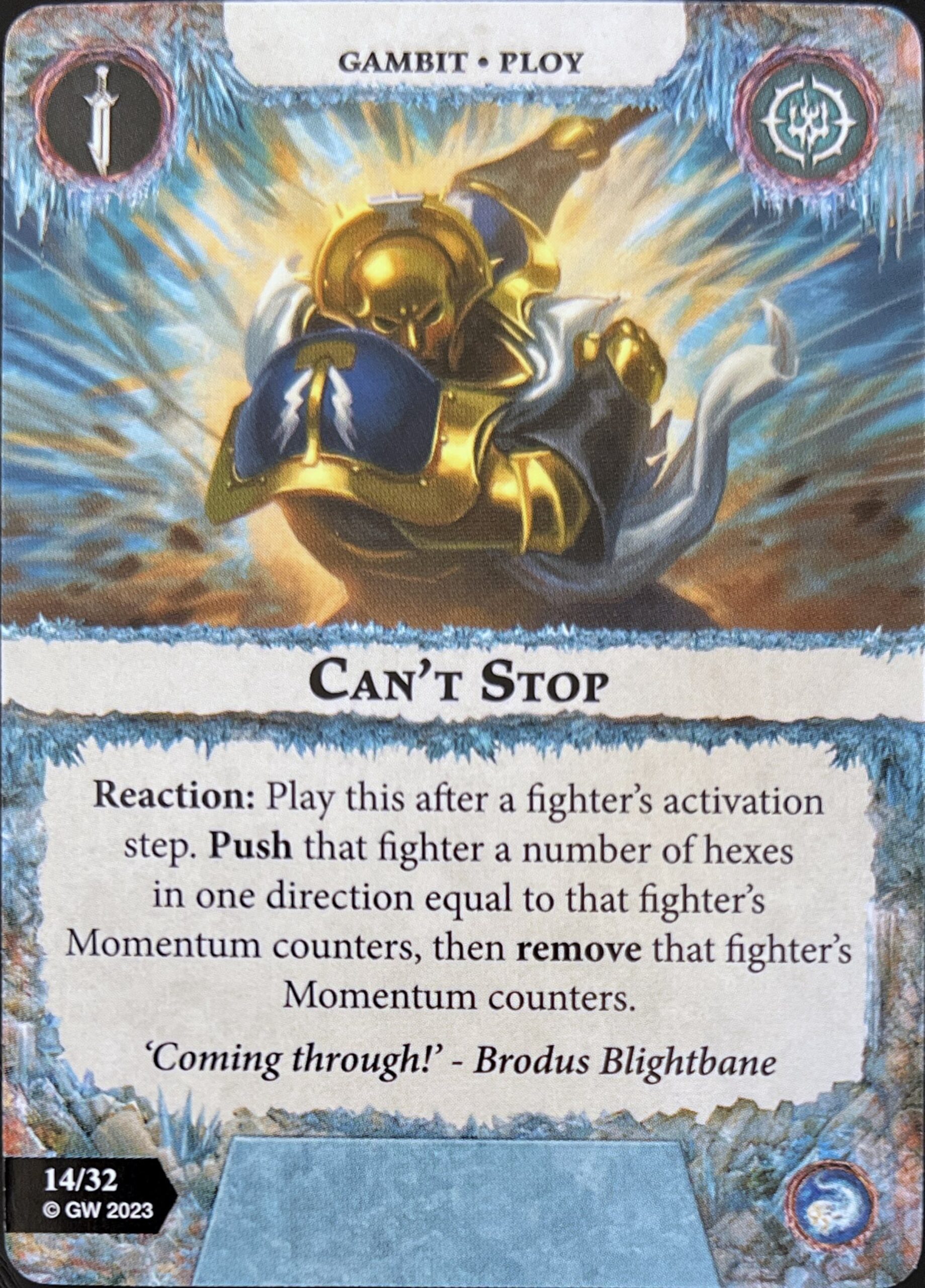
Our first gambit is Breakneck Pace. It’s been a while since we’ve seen a straight-up +2 Move gambit, I think we may have forgotten how much value they have! We haven’t had one this good since [![]() Outrun Death]
Outrun Death]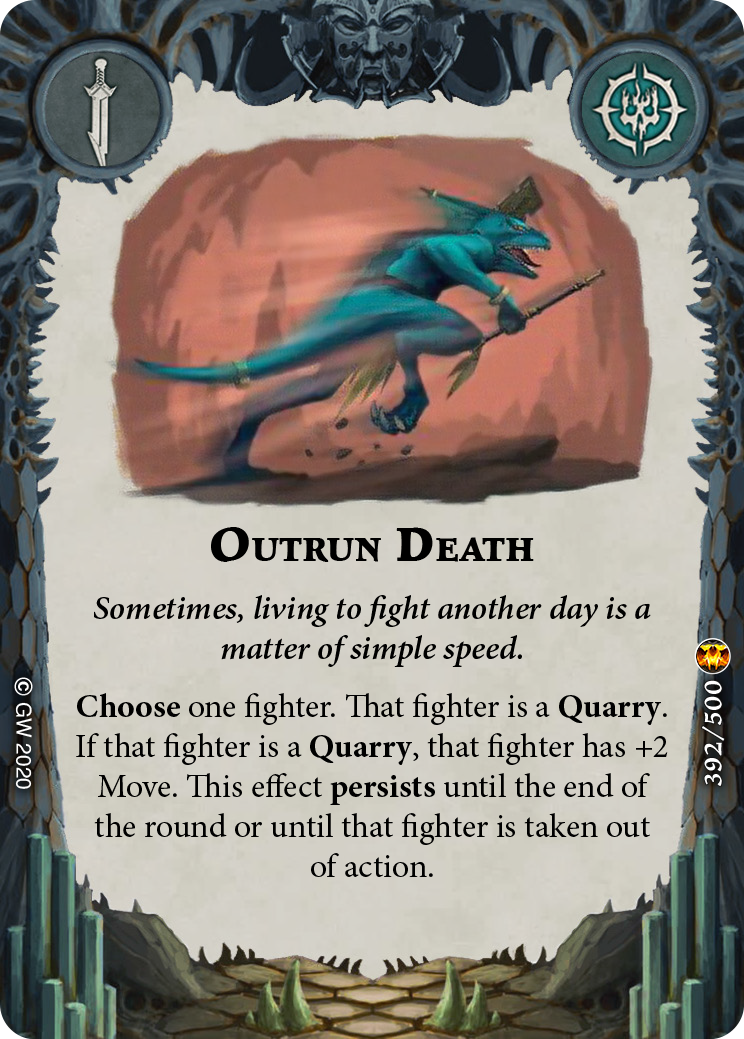 , in my opinion. Additionally, by giving you the Momentum counter, you are effectively getting +3 Move, which is absurd. Sure, you are potentially giving up the Impetus push on the back end (if you have no ways to transfer or extinguish your counters), but for the ability to absolutely torpedo a fighter on the backline, this seems very worth to me. Clawpack like this to target down leaders hiding way in the back, but pretty much any aggro warband appreciates the reach and surprise potential of a card like this.
, in my opinion. Additionally, by giving you the Momentum counter, you are effectively getting +3 Move, which is absurd. Sure, you are potentially giving up the Impetus push on the back end (if you have no ways to transfer or extinguish your counters), but for the ability to absolutely torpedo a fighter on the backline, this seems very worth to me. Clawpack like this to target down leaders hiding way in the back, but pretty much any aggro warband appreciates the reach and surprise potential of a card like this.
Power Ceiling: 3, Consistency: 3, Universality: 2
Can’t Stop is one of those ways to consume your Momentum counters wisely. After a fighter with one or more Momentum counters activates, push them a number of hexes equal to their counters, them remove them. While this is great if you want to deny your opponent an Impetus push, note that it doesn’t specify it has to be a friendly fighter. Sure, if your opponent activates and has this card too, they have priority on you, but otherwise you get to push them wherever you like, you don’t have to do the straight-line Impetus push. I do think you still prefer to use it on yourself for a potential multi-hex push, but the flexibility is great and the upside is tremendous if you are leaning into this deck.
Power Ceiling: 3, Consistency: 2, Universality: 2
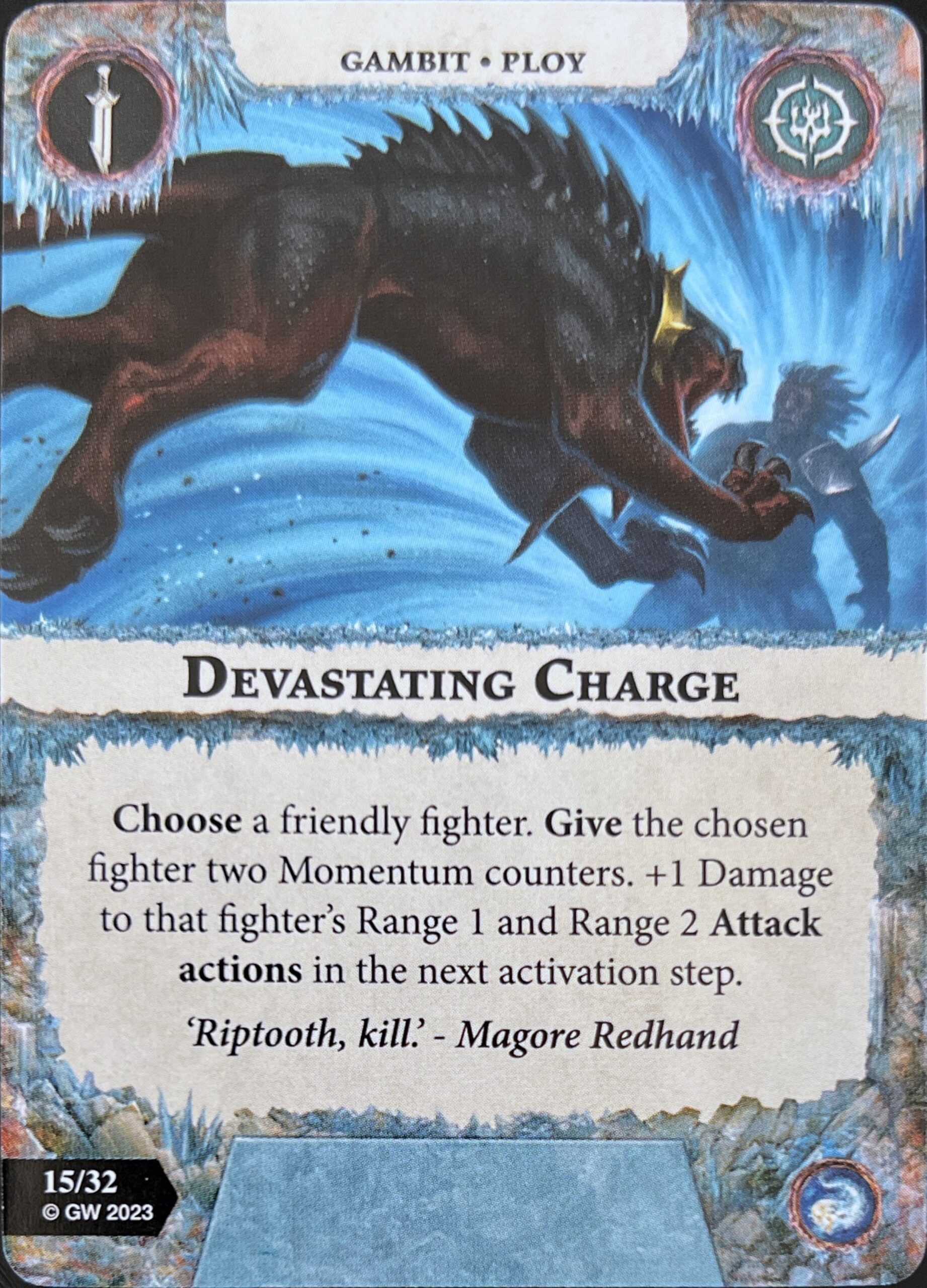
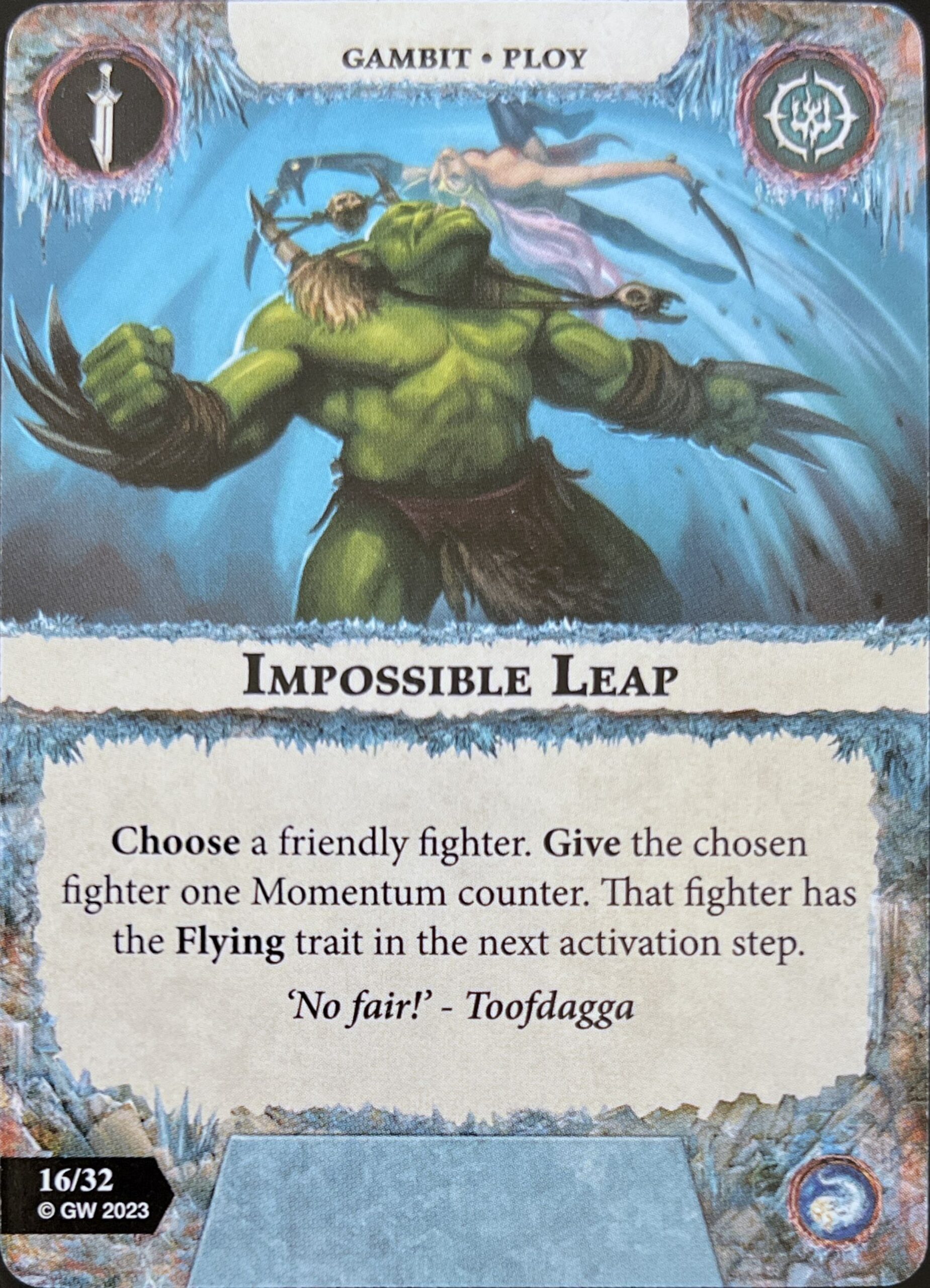
I like how nicely these first three gambits chain into each other. Our third is Devastating Charge, which grants you +1 Damage in your next activation (Range 1 and 2 only) at the “cost” of 2 Momentum Counters. I’m just imagining playing all 3 of these on a single fighter in a quick sequence, charging an extra 3 hexes for an extra damage, then pushing yourself another 3 hexes at the end of it. Granted, and this applies to a lot of the Momentum-generating power cards, you will have to watch out for cards like [![]() Freezing Venom]
Freezing Venom]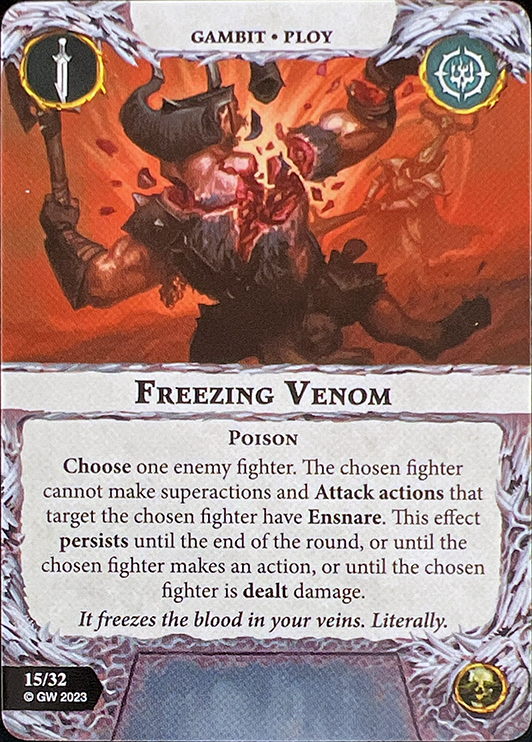 and [
and [![]() Ill-prepared]
Ill-prepared]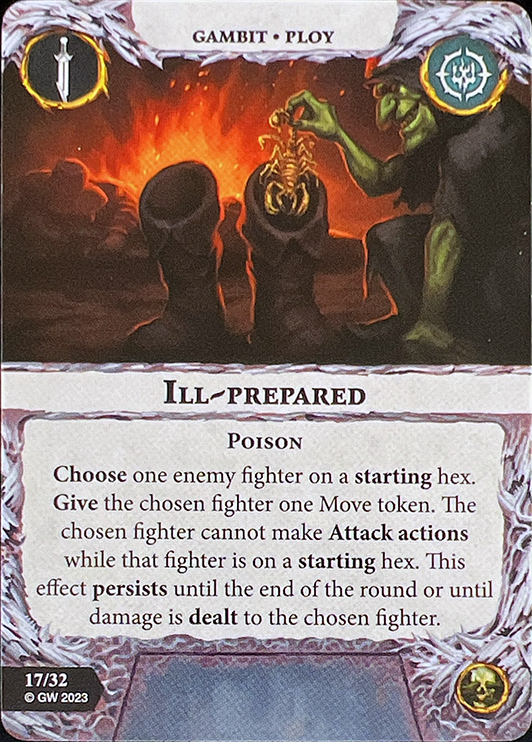 that can shut down a charge, as you’ll not only lose bonuses but also potentially get pushed into oblivion by your opponent. Still, the deck, as a whole, balances out these high risks with high rewards and this one seems really solid when in hand together with the reactions that let you remove or transfer counters. Of course, you do still need to land the attack, so it’s definitely not all upside here.
that can shut down a charge, as you’ll not only lose bonuses but also potentially get pushed into oblivion by your opponent. Still, the deck, as a whole, balances out these high risks with high rewards and this one seems really solid when in hand together with the reactions that let you remove or transfer counters. Of course, you do still need to land the attack, so it’s definitely not all upside here.
Power Ceiling: 2, Consistency: 2, Universality: 3
Next up is Impossible Leap, which gives you the flying trait in the next activation, again with a “cost” of a Momentum counter. If you are struggling for counter generation for some reason, this does have some value, but flying is a bit meh when you could instead just take +2 Move. Flying is also not particularly likely to be useful if you have low Move characteristics and/or plan to play a more passive game anyway. That being said, the changes to the available feature tokens to include blocked hexes and the increased accessibility via the Plunder reaction do make flying a tad more valuable, so this could open up some plays you might not otherwise have.
Power Ceiling: 1, Consistency: 2, Universality: 2
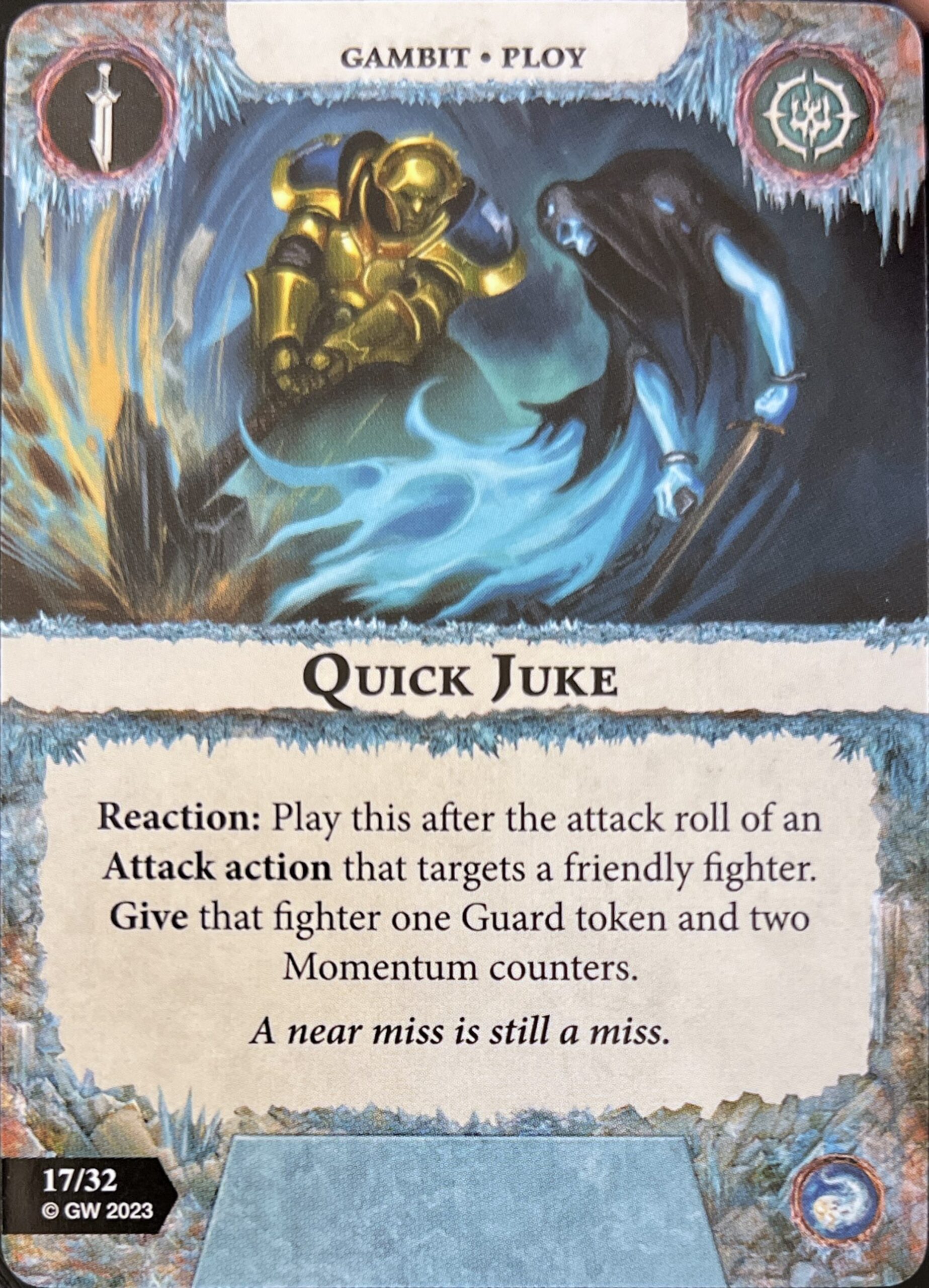
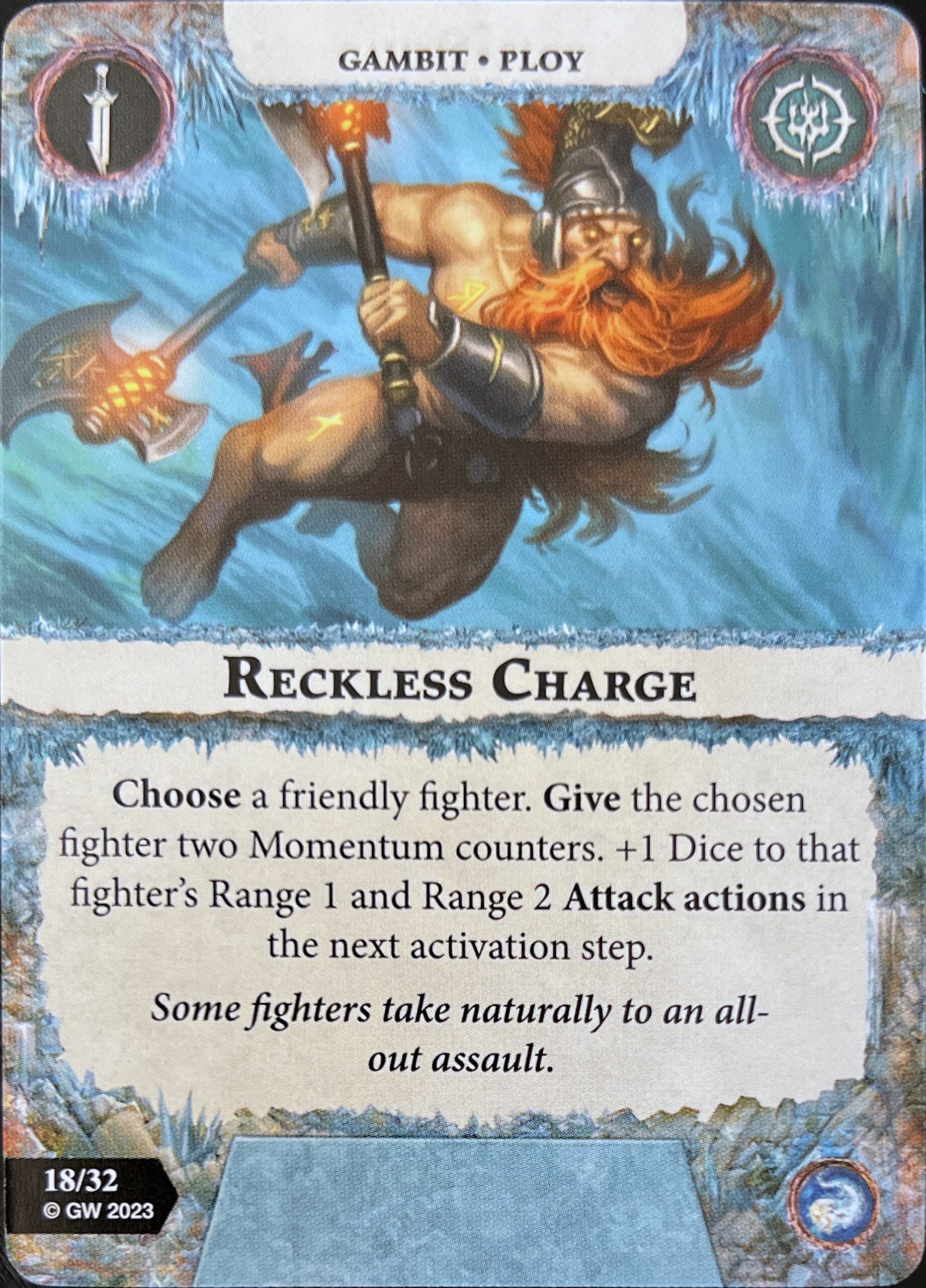
Quick Juke allows you to grab a guard token after your opponent’s attack roll targeting one of your fighters while also giving them two momentum counters. This is a very cute way to bait somebody to attack a staggered fighter (perhaps from an earlier Impetus) or otherwise exposed fighter, then take that guard at the last minute. I could see taking this on a 2-Dodge warband, but of course you do need to be aware that you’ll immediately be handing your opponent a pretty juicy Impetus after the attack. I think this does impact the value of the card pretty heavily, but pulling this off and drastically swinging the odds of success for your opponent could be a real turning point in a game.
Power Ceiling: 2, Consistency: 2, Universality: 2
The counterpart to Devastating Charge, we have Reckless Charge, which carries the same “penalty” of gaining two momentum counters, but with the effect this time being +1 Dice (on Range 1 and 2). I do think extra accuracy is generally the more valuable of the two effects, but I see both gambits in pretty much the same light. You mostly want to be using them leading into activations where you plan to remove or transfer counters, as you’re otherwise likely to get punished heavily by your opponent immediately afterwards. I do wish this was just flat +Dice at any Range, but I suppose the deck’s built-in methods to leverage the counters and inherent +Move the counters give were enough reward to merit a bit of a restriction.
Power Ceiling: 2, Consistency: 2, Universality: 3
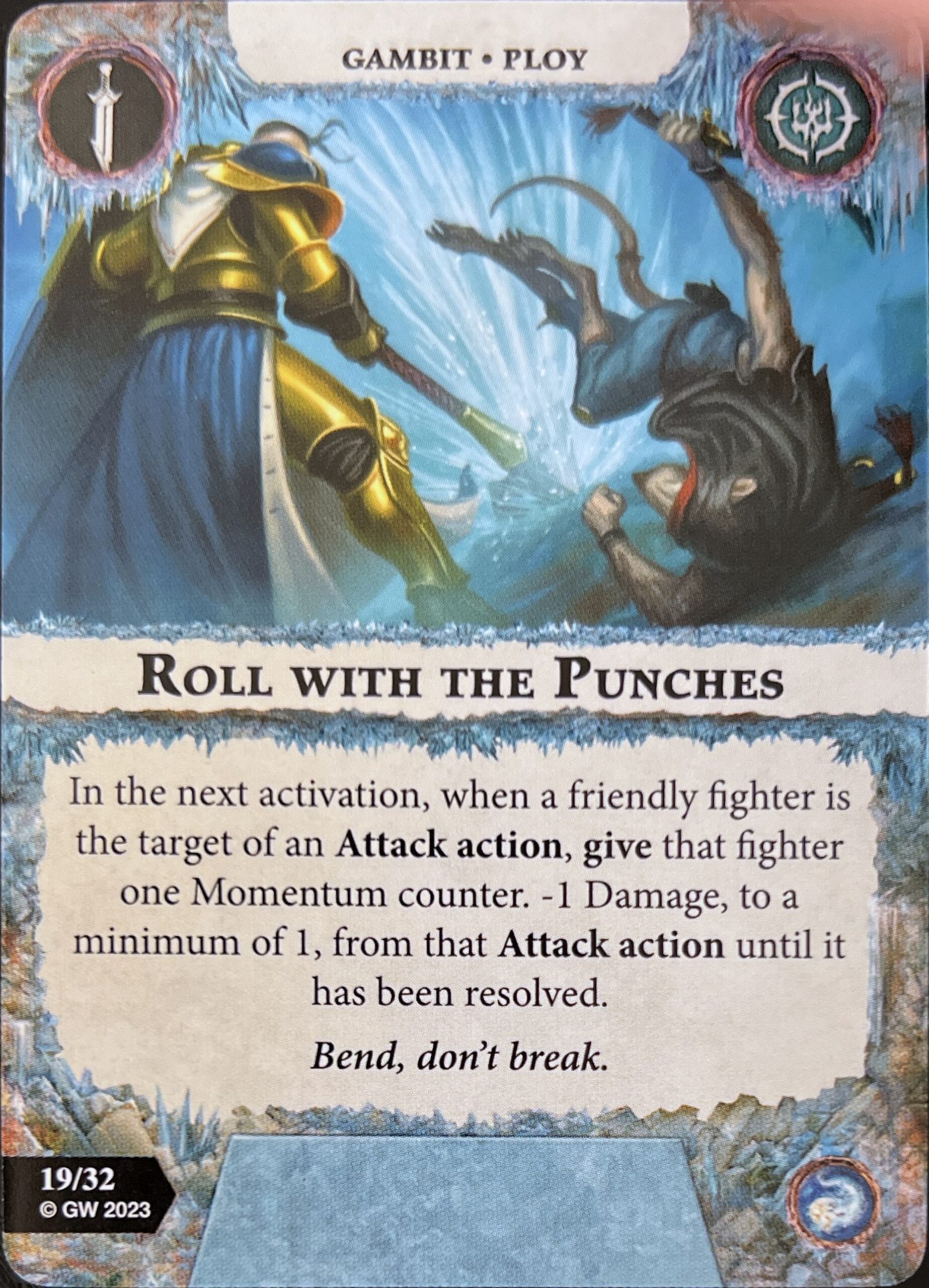
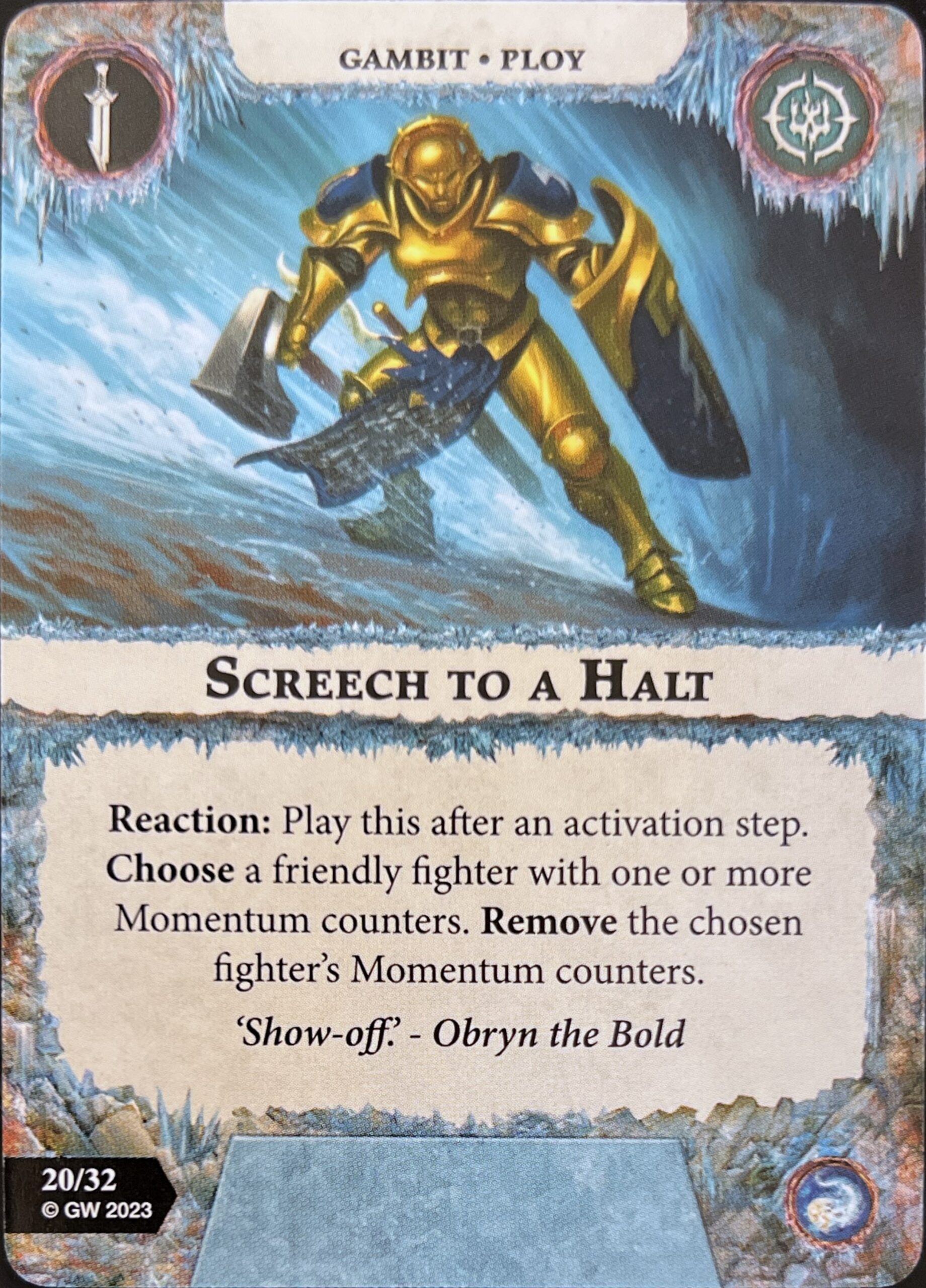
Roll with the Punches grants you -1 Damage in the next activation when you are targeted by an attack action, in addition to gaining a Momentum counter. Notably, this can apply to more than one attack if your opponent is making a scything attack or something like the Exiled Dead superactions. While this can be a nice way to deter a single round of attacks, needing to choose whether to take the counter before dice are rolled means you might be gaining them even if your opponent ends up missing the attack. Since there are other purposes to the counters, that may not be such a bad thing, but it could mean you get hit with an unfortunate Impetus in cases where you don’t necessarily need to. -Damage gambits are typically better off hidden as reactions, but, even telegraphed, this at least could delay your opponent’s plans for a critical turn.
Power Ceiling: 2, Consistency: 2, Universality: 3
Screech to a Halt is a reaction allowing you to remove the Momentum counters from a single friendly fighter after an activation. Note from the plot card that Impetus does resolve after reactions to the activation, so you can use this to cover something like a Momentum-heavy charge before your opponent gets to push you. However, unlike Can’t Stop, you don’t have the upside of getting to do something with those counters. It’s not a bad idea to have some redundancy in counter removal tech, but the absence of additional value pushes this one down a bit.
Power Ceiling: 1, Consistency: 2, Universality: 3
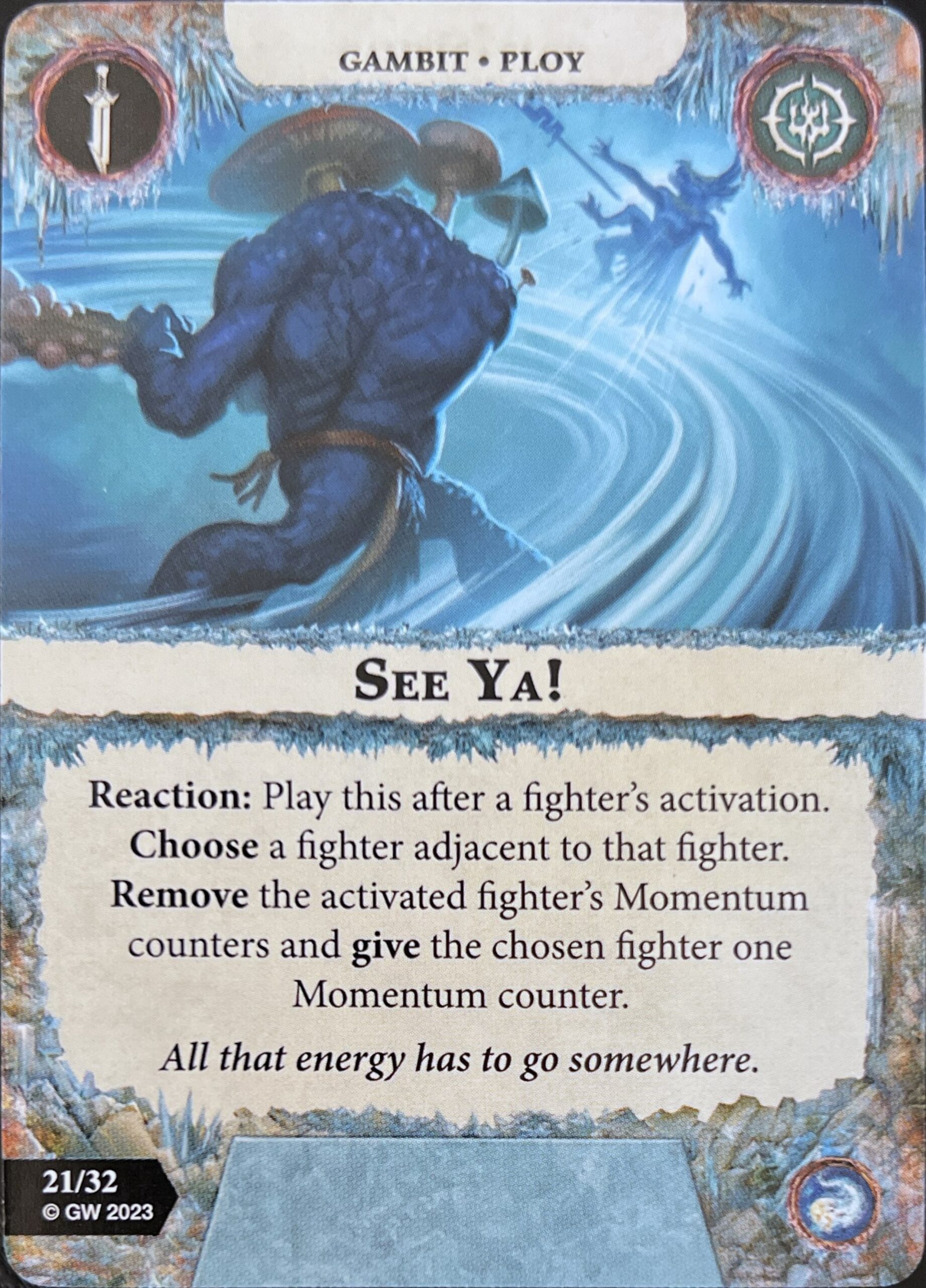
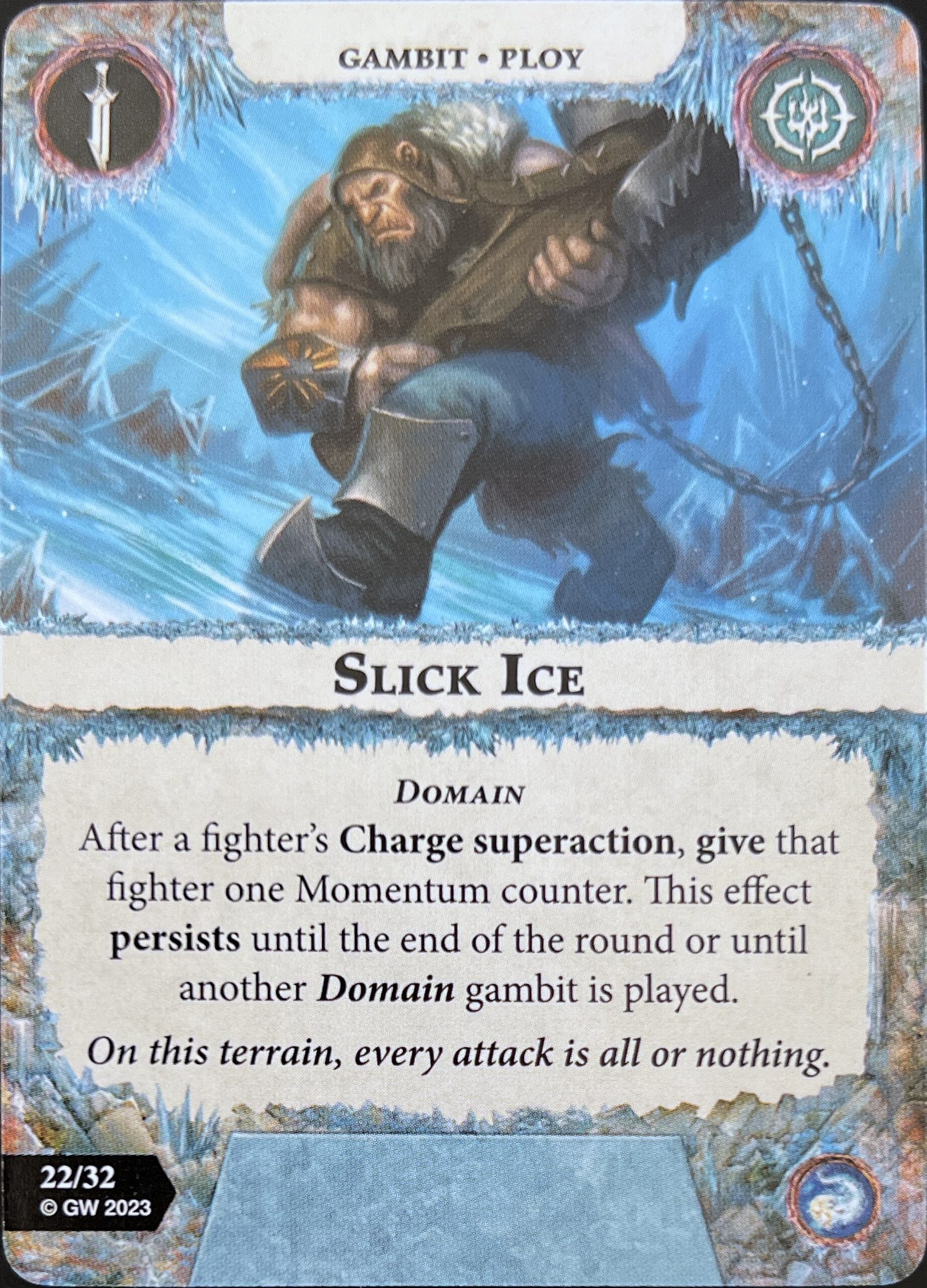
EDITED: See Ya! is a better example of the type of thing I’d like to be dissipating my counters with. Transferring them (one) to an enemy fighter is some incredible value. Being able to load a fighter up with counters, make a beefed-up charge, then not only avoiding the downside of an Impetus, but also opening your opponent up to one can cause some crazy swings. Being able to control where somebody like a Mollog is able to exist (unless they have a “cannot be pushed” effect) has huge implications. If your opponent is not using this Rivals deck, they’ll have no way to remove the counters and are just at your mercy for where you’d like to leave him, and you could also leverage the push directly into a stagger if you don’t care to put that fighter anywhere in particular.
Power Ceiling: 3, Consistency: 2, Universality: 3
Slick Ice is a domain that gives each fighter that makes a charge superaction a Momentum counter after the charge is resolved. My understanding is that this should proc prior to the window in which you resolve the Impetus ability, so the presumption here is that you’ll go charge>counter>reactions>Impetus. This will create some absolute chaos throughout the round. By the end of it, you’d expect at least 3 fighters on each side to have been given counters and have been pushed all over the place. Oddly enough, I feel like this is generally the kind of card you would take in order to counterplay aggro rather than to play aggro, as more passive-scoring warbands could probably forgo making as many charges, if this card is in play. I suppose there is an argument to be made that aggro warbands care less about their positioning, and so there would some value in disrupting opponents’ positional scoring, but handing out several pushes (potentially out of range of future charges) is a dangerous prospect. I could see this providing some Momentum counter synergy in the deck if you got the counter after the move part of the charge, but as written, unless you can abuse the “charged out” rule, the odds are not great that you can do exactly what you want to with those counters. The only convincing argument I think I could make here would be to use this as an Exiled Dead player, since you’re not planning to charge much anyway, then use the Momentum counters your opponent’s fighters collect to push them into the midst of your zombie horde and pick up some free staggers (a la [![]() Tangled Roots]
Tangled Roots]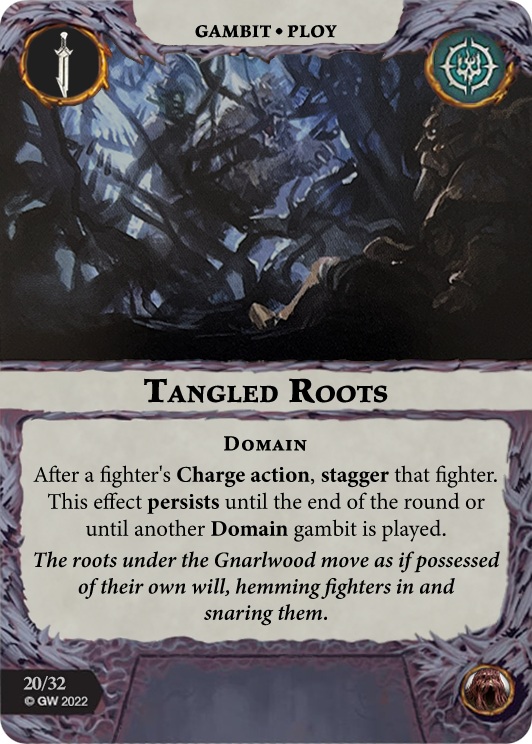 ).
).
Power Ceiling: 1, Consistency: 2, Universality: 1
- Mark: See Ya!
- Aman: Devastating Charge
- Zach: See Ya!
- George: Breakneck Pace
Upgrades
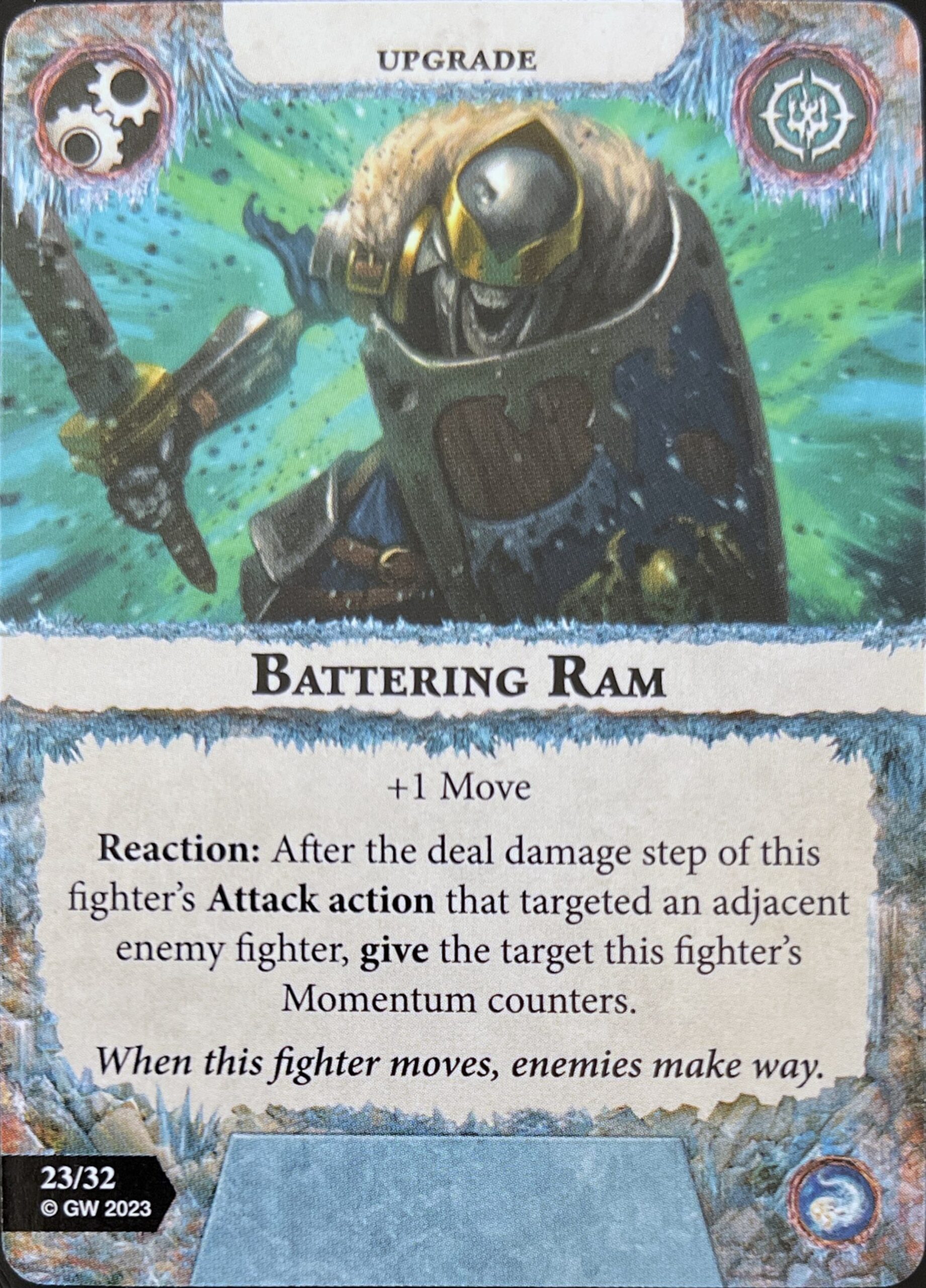
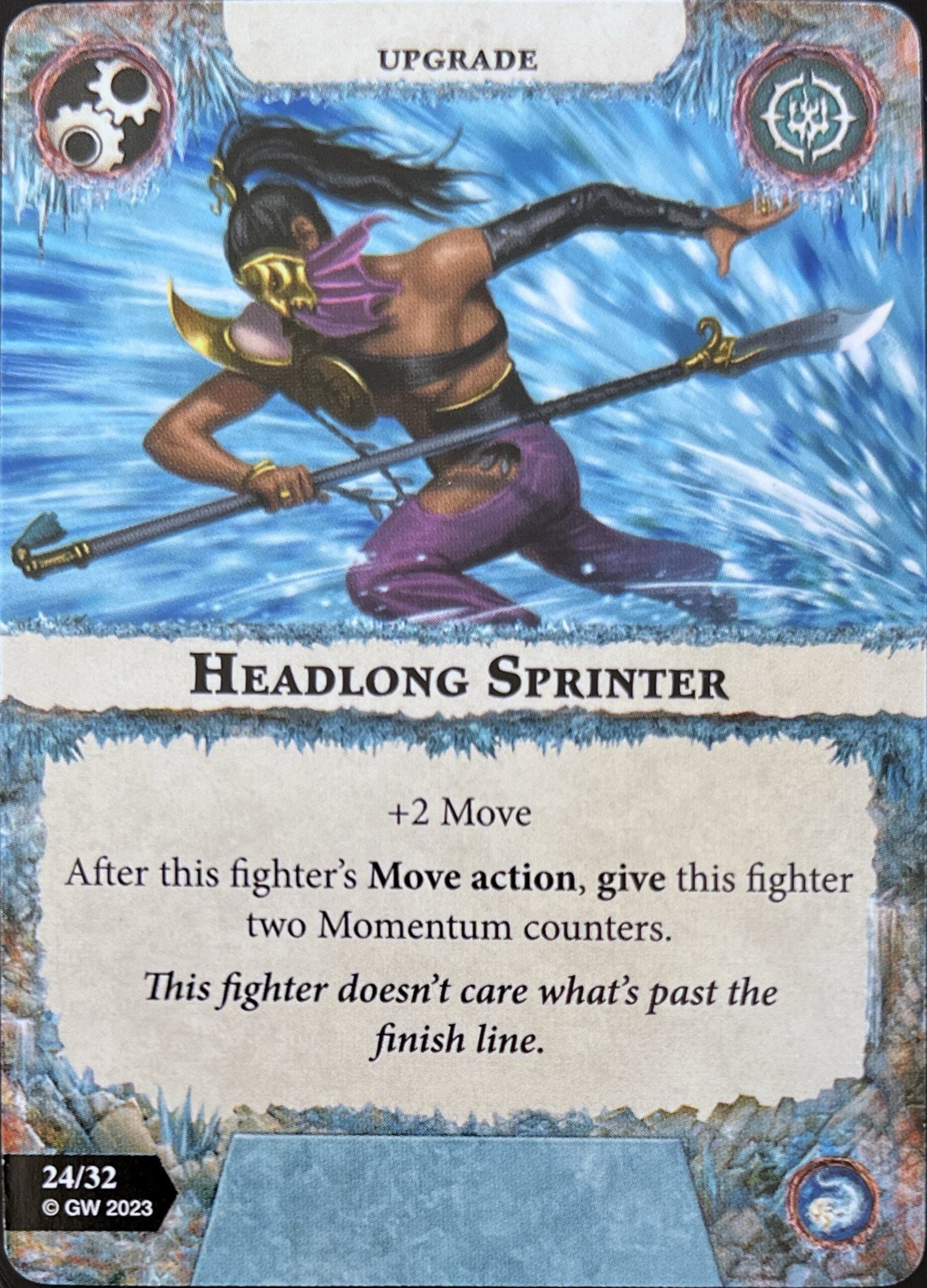
Our first upgrade is Battering Ram, which is a nice little [![]() Great Speed]
Great Speed]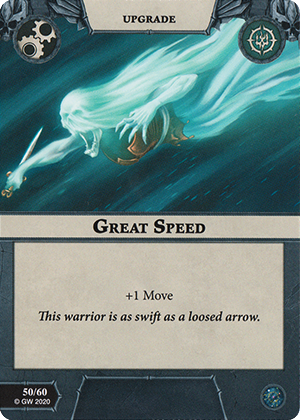 + for this deck. You get the base +1 Move, but also gain a reaction to transfer your Momentum counters to the target of your attack action after the deal damage step. I do find it a bit odd that See Ya! is totally agnostic to what the fighter does in their activation while this one requires you to both attack and succeed to transfer the counters. Perhaps the distinguishing line was that you give them all of your counters instead of just one, but I’m not sure that fully justifies the increased difficulty. Given that you’d like to be attacking, succeeding, and killing the fighters you go after, I’m a bit worried that the combination of kills and misses means that, more often than not, you will end up in situations where you can’t actually use the reaction and this card provides far less than market value for your upgrade slot. Sure, those cases where you can transfer a bunch of tokens to your opponent’s most valuable fighter will be cool, but I don’t think that’s going to be as reliable, or even necessarily desirable, of a scenario as I’d like.
+ for this deck. You get the base +1 Move, but also gain a reaction to transfer your Momentum counters to the target of your attack action after the deal damage step. I do find it a bit odd that See Ya! is totally agnostic to what the fighter does in their activation while this one requires you to both attack and succeed to transfer the counters. Perhaps the distinguishing line was that you give them all of your counters instead of just one, but I’m not sure that fully justifies the increased difficulty. Given that you’d like to be attacking, succeeding, and killing the fighters you go after, I’m a bit worried that the combination of kills and misses means that, more often than not, you will end up in situations where you can’t actually use the reaction and this card provides far less than market value for your upgrade slot. Sure, those cases where you can transfer a bunch of tokens to your opponent’s most valuable fighter will be cool, but I don’t think that’s going to be as reliable, or even necessarily desirable, of a scenario as I’d like.
Power Ceiling: 2, Consistency: 1, Universality: 2
Headlong Sprinter is more mobility, granting the equipped fighter +2 Move while handing them 2 Momentum counters after they make a Move action. This certainly does get more value added the more you lean into the gimmick of the deck, but even just the base value of +2 Move, especially if you have “cannot be pushed” effects in your deck, is quite high on many aggro warbands.
Power Ceiling: 2, Consistency: 3, Universality: 2
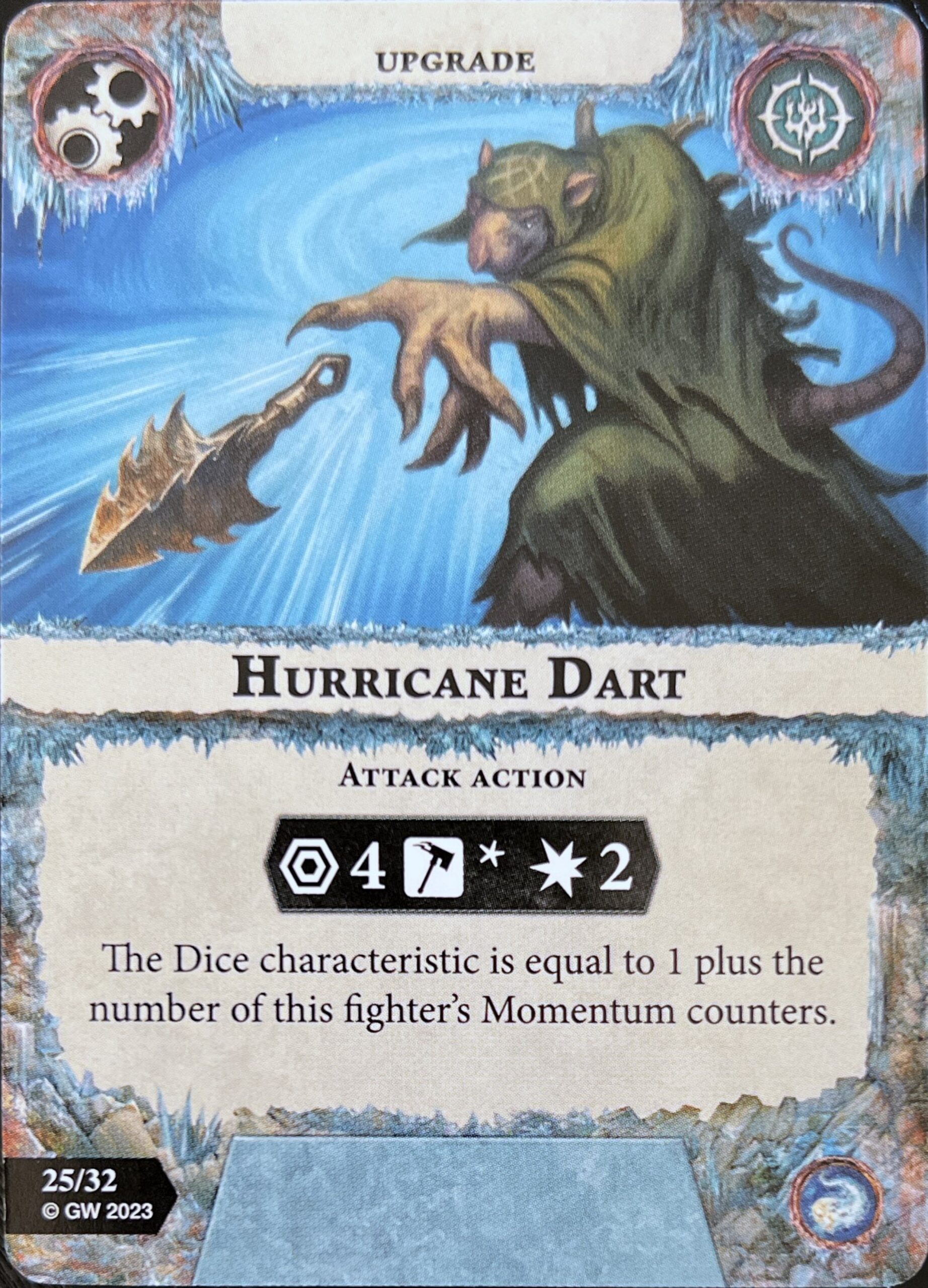
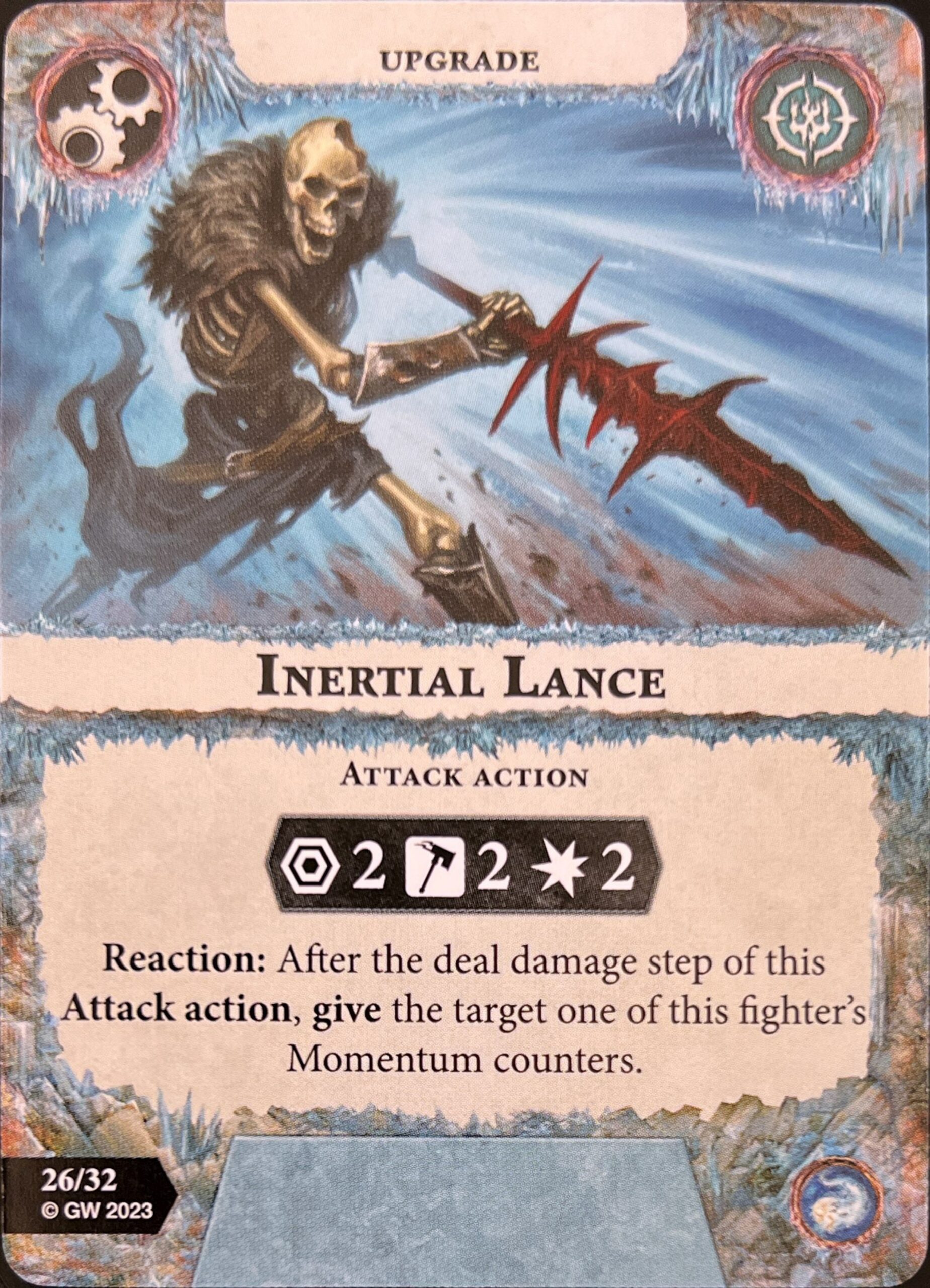
Hurricane Dart further explores the Range 4 attack action design space, but I worry they may have gone too far with this one. It’s a 4R/*H/2D attack, where the Dice characteristic is 1 plus the number of Momentum counters you have. Sure, this does require you to combo with other cards in the deck to increase the accuracy, but even having a single Momentum counter turns this into 4R/2H/2D, which is an insanely good ranged attack (as Ephilim has shown us). Even for just a simple combo with our previous entry in Headlong Sprinter, you can charge, gain 2 counters, then throw out a ridiculous 4R/3H/2D attack. Pack in cards like [![]() Gloryseeker]
Gloryseeker]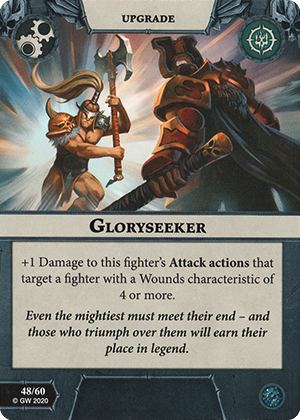 and even [
and even [![]() Fighter’s Ferocity]
Fighter’s Ferocity]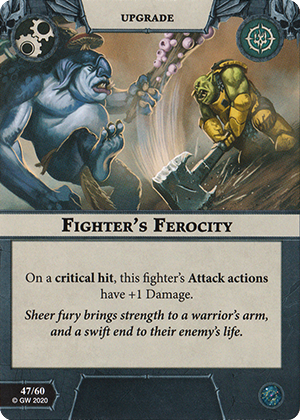 and you could potentially be absolutely lethal from distance. Again, this does put quite a bit of onus on the rest of your power deck to give you some Momentum generation, and you are leaving yourself vulnerable to Impetus, but there is quite a bit of upside, especially late in the game once you have generated a lot of counters. Clawpack seem to be a decently natural pairing here given their access to [
and you could potentially be absolutely lethal from distance. Again, this does put quite a bit of onus on the rest of your power deck to give you some Momentum generation, and you are leaving yourself vulnerable to Impetus, but there is quite a bit of upside, especially late in the game once you have generated a lot of counters. Clawpack seem to be a decently natural pairing here given their access to [![]() Prehensile Tail]
Prehensile Tail]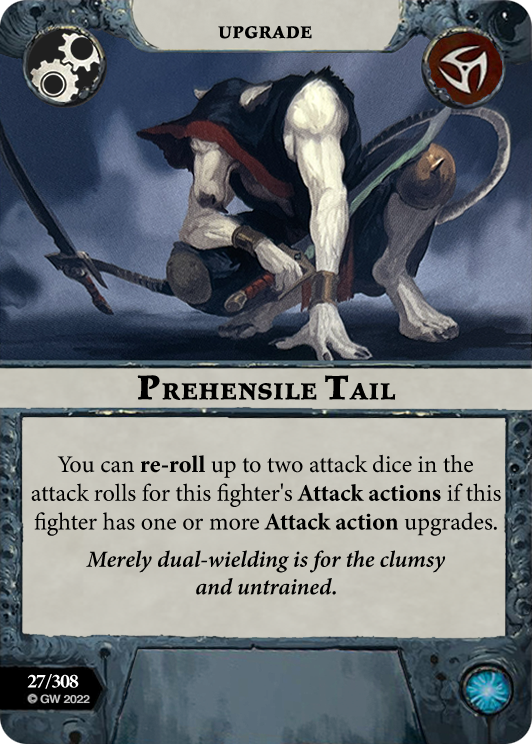 , but I could definitely see a number of warbands being interested in this to boost their ranged threat presence.
, but I could definitely see a number of warbands being interested in this to boost their ranged threat presence.
Power Ceiling: 2, Consistency: 2, Universality: 2
Back-to-back weapon upgrades, here we have the Inertial Lance, which is a 2R/2H/2D attack action that gives you a reaction to transfer one Momentum counter to the target of the attack after the deal damage step of the attack. This reaction does run into the same issue as Battering Ram with respect to the infrequency where it will actually provide value, but at least the straight effect as an attack action is solid in its own right. This is especially true again for [![]() Prehensile Tail]
Prehensile Tail] synergy to basically turn it into [
synergy to basically turn it into [![]() Guardian Glaive]
Guardian Glaive]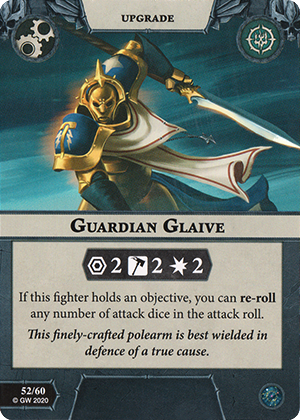 , but on any hex on the board and with the upside of maybe the reaction being useful. I like that the reaction is not, I expect, going to be the featured part of the card, but I do recognize that the number of warbands who actually need an attack action upgrade with a solid, but “nothing special” profile is quite low.
, but on any hex on the board and with the upside of maybe the reaction being useful. I like that the reaction is not, I expect, going to be the featured part of the card, but I do recognize that the number of warbands who actually need an attack action upgrade with a solid, but “nothing special” profile is quite low.
Power Ceiling: 1, Consistency: 3, Universality: 1
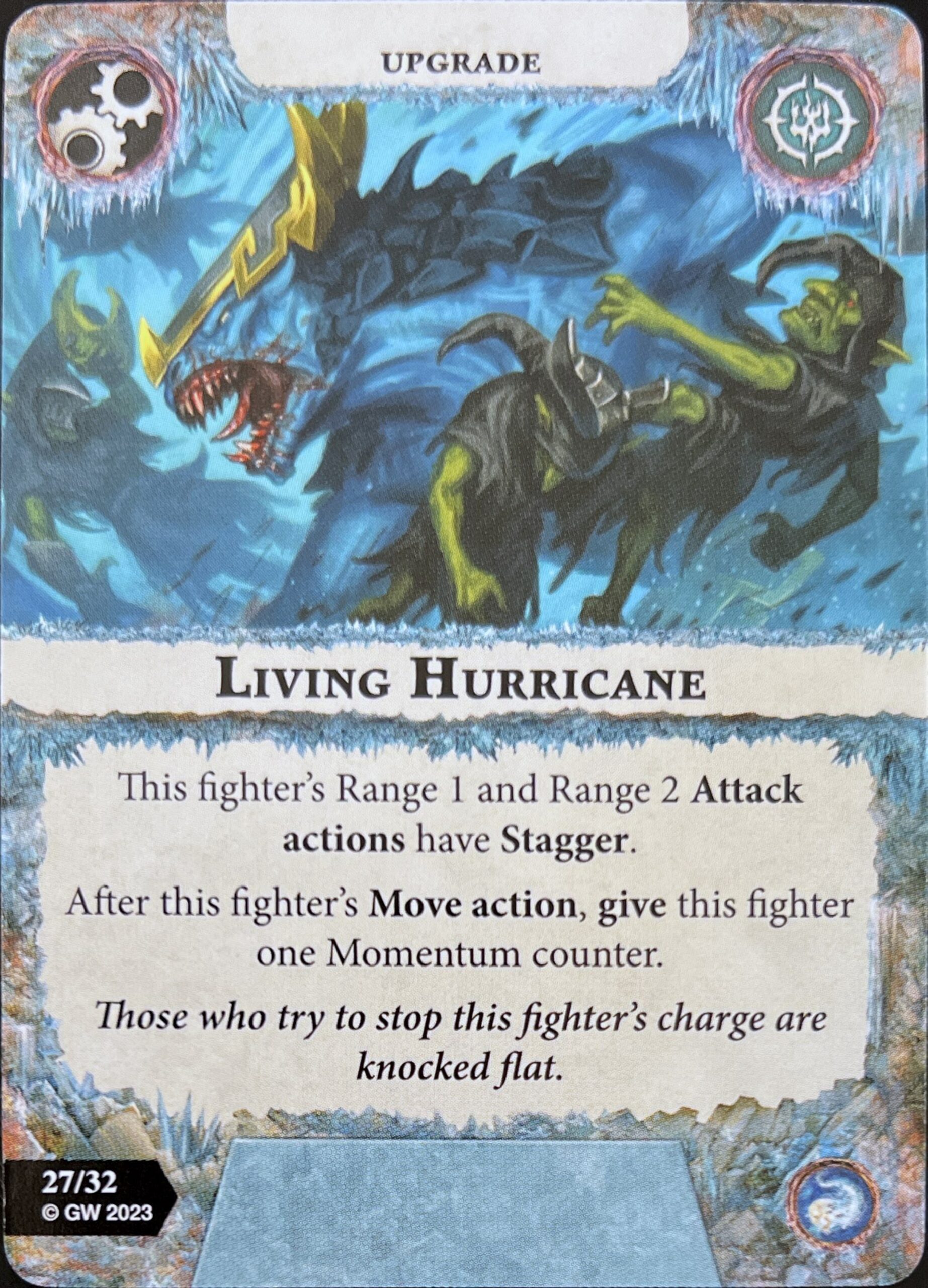
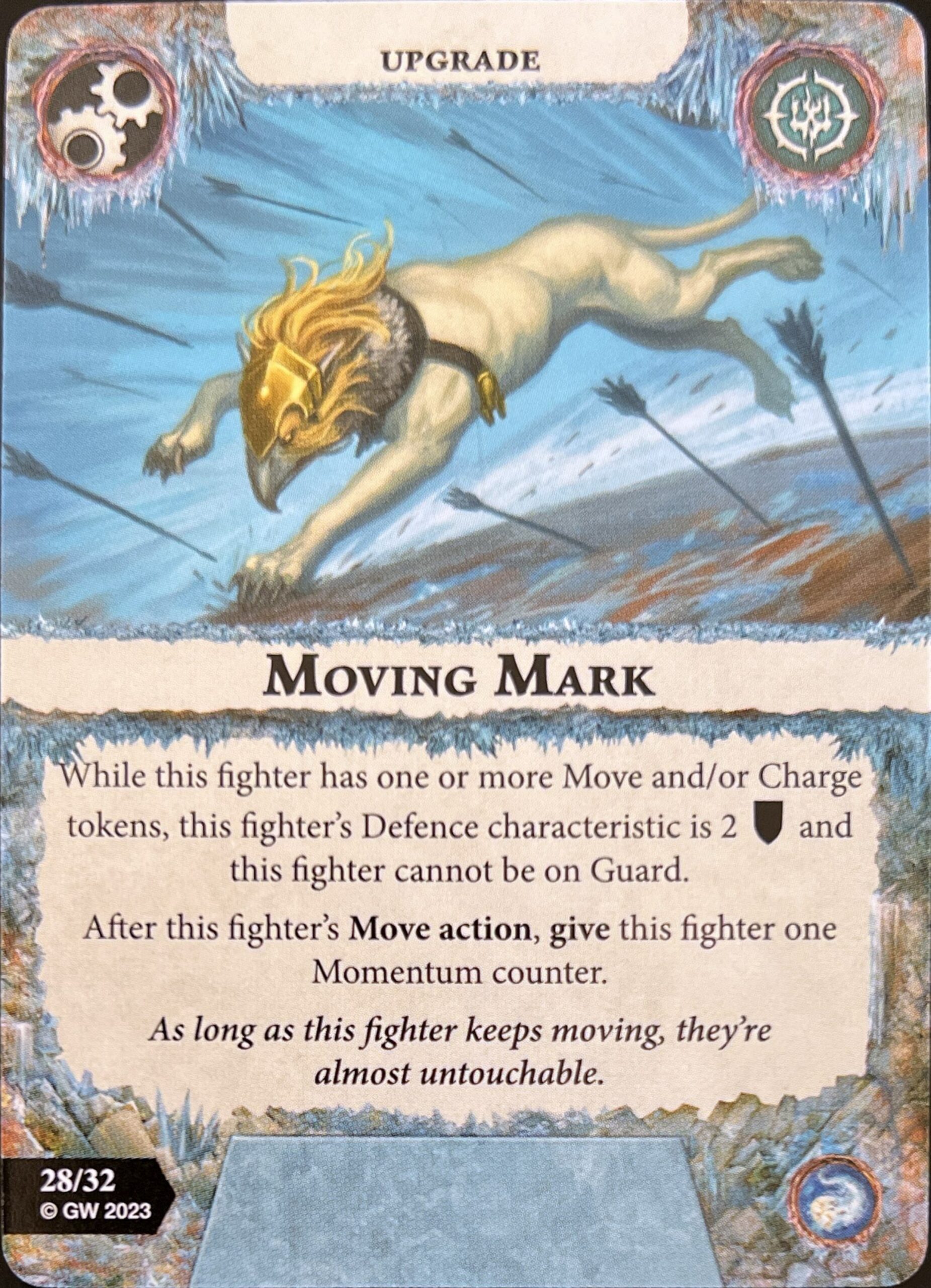
Next up is Living Hurricane, which grants you stagger on your Range 1 and 2 attacks while also giving you a Momentum counter after the equipped fighter’s move action. Stagger as an upgrade has always been a pretty meager bonus. The game is slowly rewarding stagger more and more with cards like [![]() Opportunistic Reprisal]
Opportunistic Reprisal]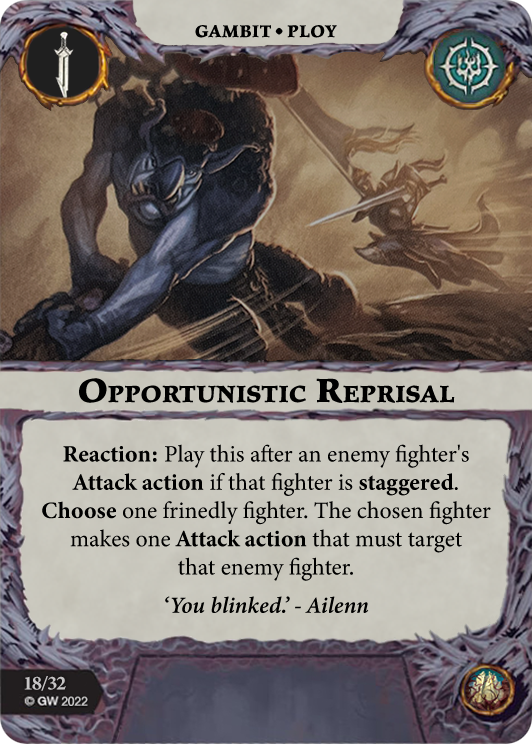 , and fighters like the zombies in the Exiled Dead or [
, and fighters like the zombies in the Exiled Dead or [![]() Merciless]
Merciless]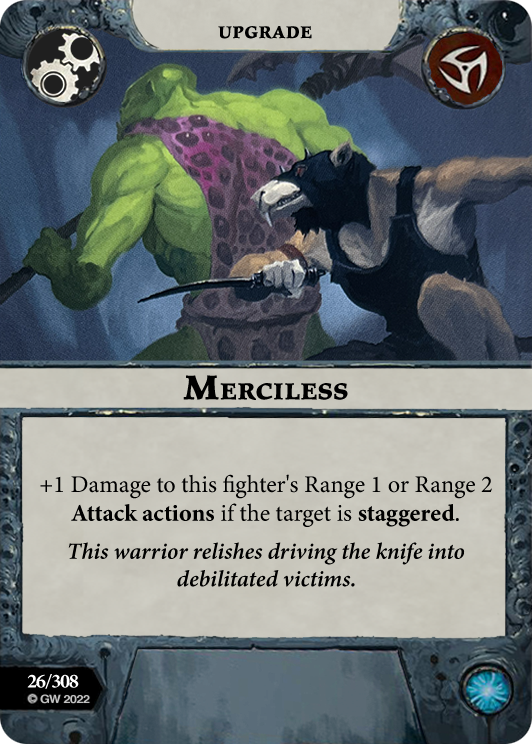 -equipped fighters in Clawpack can capitalize on staggered enemies. That being said, unless you are also bringing a lot of the Momentum counter payoff in this deck (which I think you really only bring a lot of in Nemesis), you’re not getting enough value here for what is a very tight set of 10 upgrades these days.
-equipped fighters in Clawpack can capitalize on staggered enemies. That being said, unless you are also bringing a lot of the Momentum counter payoff in this deck (which I think you really only bring a lot of in Nemesis), you’re not getting enough value here for what is a very tight set of 10 upgrades these days.
Power Ceiling: 1, Consistency: 2, Universality: 2
Moving Mark grants the equipped fighter a Defence characteristic of 2 when they have a Move/Charge token while preventing them from being on Guard. Like several of these other upgrades, you also gain one Momentum counter after you make a move action. I like this one quite a bit, particularly on warbands with base 1 Shield or 1 Dodge defence anyway. At that point, the defensive benefit of being on Guard is far outweighed by the addition of a second die, especially for warbands who don’t care so much about positional scoring like Magore’s Fiends. That being said, you will have to be careful about the counter generation, as you could find yourself suddenly out of position if you are not careful. For example, you might not want to slap this on a fighter like Mollog unless you have “cannot be pushed” tech in the deck to back him up. Still, what could effectively be +1 Defence on a lot of a fighters is pretty attractive, I could see a number of aggro warbands profiting off this card with a more survivable beatstick of a fighter.
Power Ceiling: 2, Consistency: 3, Universality: 2
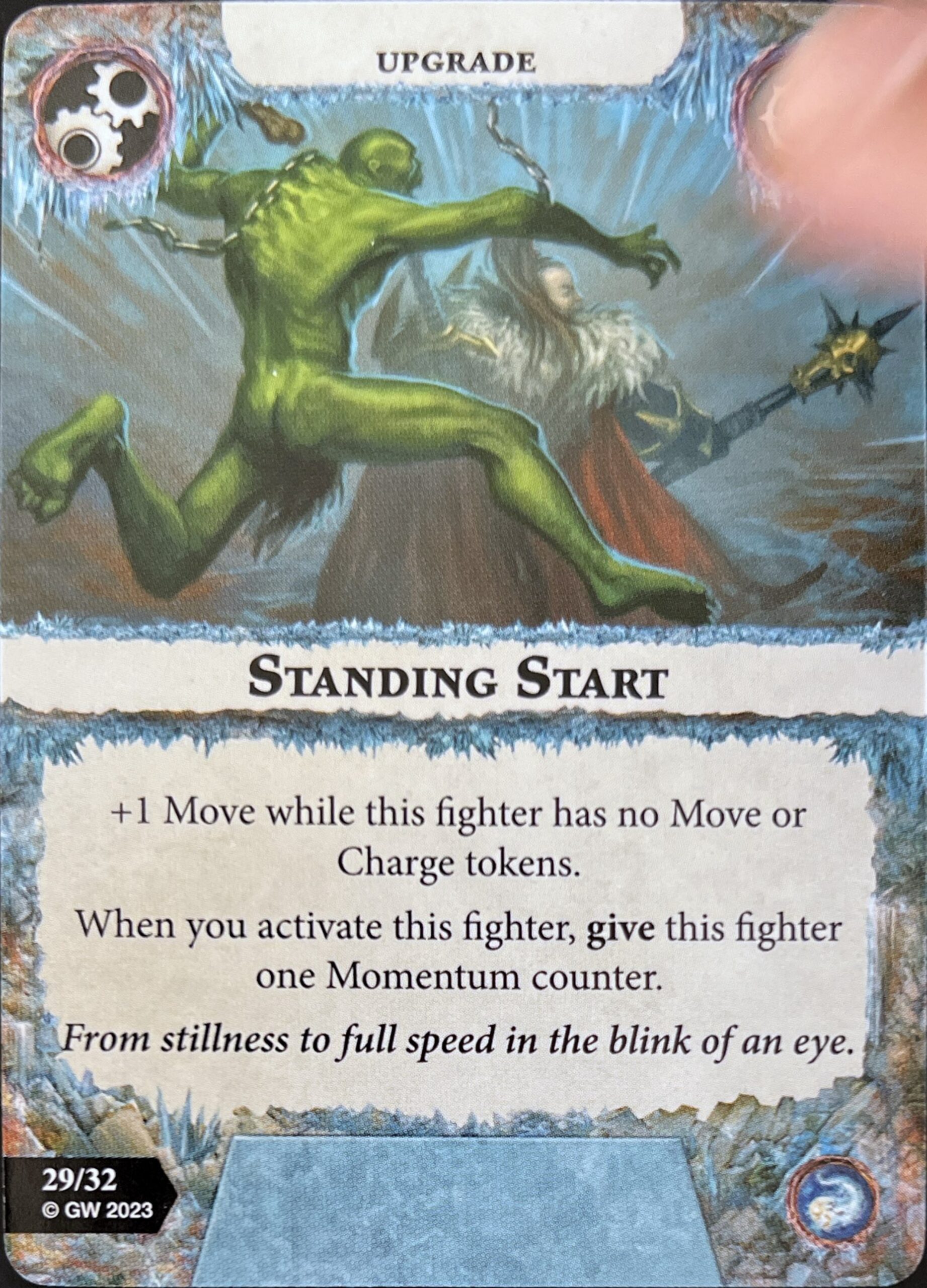
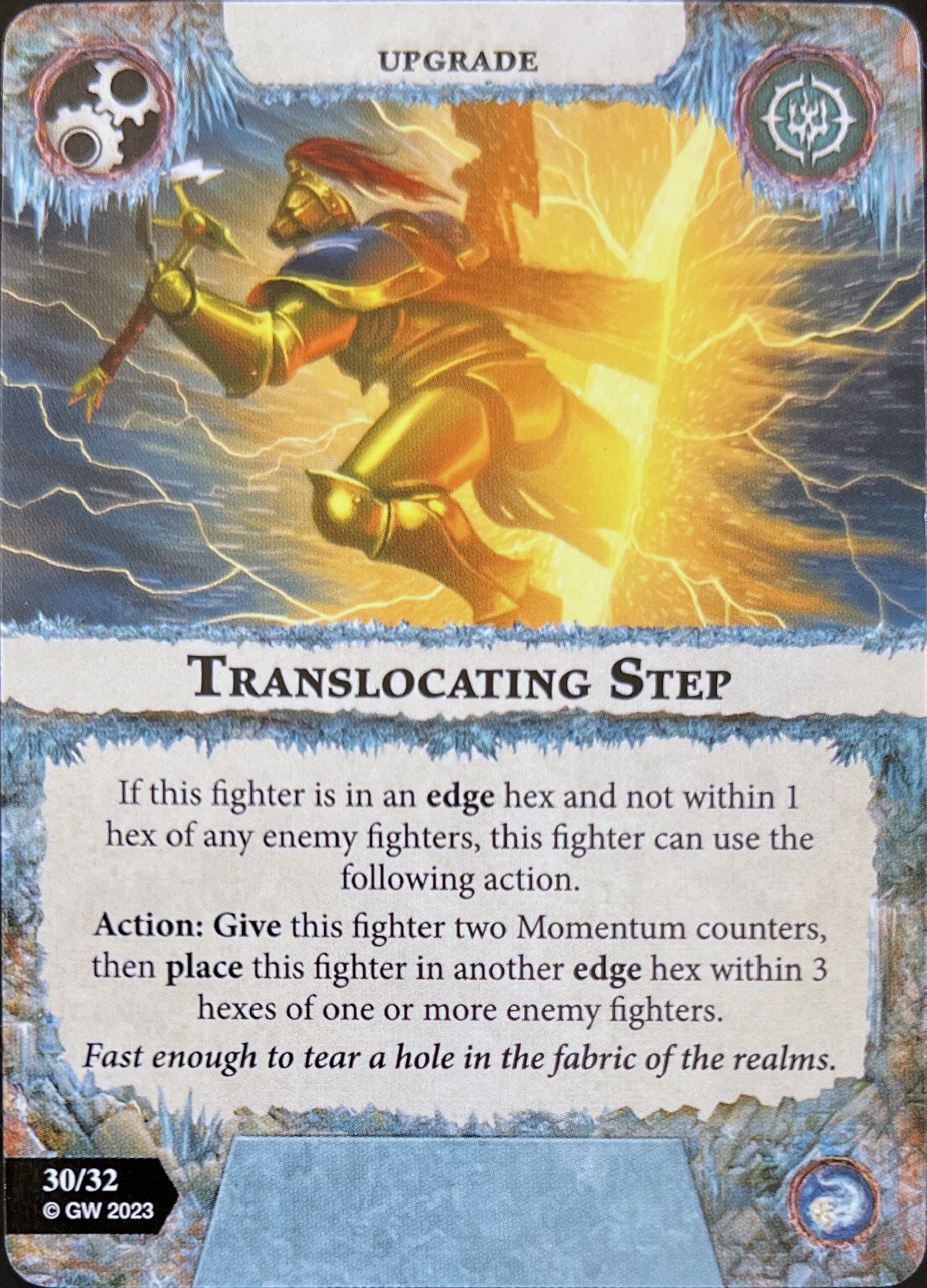
Following this, we have Standing Start, which grants the equipped fighter +1 Move while having no Move/Charge tokens and, you guessed it, gives them a Momentum counter, although this time only when they are activated. Given the base added mobility of Momentum counters in the first place, I think I would have appreciated a few less +Move cards in the upgrade deck. As I’ve mentioned for other cards, the ability to spend/transfer counters makes for some neat internal synergy, but this card’s base effect is worth far less than the flat +2 Move of Headlong Sprinter, even if it does give you one fewer counter.
Power Ceiling: 1, Consistency: 3, Universality: 2
Translocating Step lets you take an action to teleport from one edge hex (not within 1 of an enemy fighter) to another (as long as you end within 3 hexes of one or more enemy fighters) at the “cost” of 2 Momentum counters. We’ve seen a number of teleport actions/cards in the past that do something similar while giving a Move token, so I suppose this is a bit less punishing in that regard. However, the inherent problem with using a action to do this is always going to be that your opponent just immediately gets to swing at you once you’ve done so. In this case, they also get to hit you with a 2+ hex Impetus right after you spend an activation getting to wherever. I struggle to find a good use case for this, maybe off a Puppeteer? I feel like, even if there weren’t such strict limitations on where and when you could use this, I’d still not see much value in it.
Power Ceiling: 1, Consistency: 1, Universality: 1
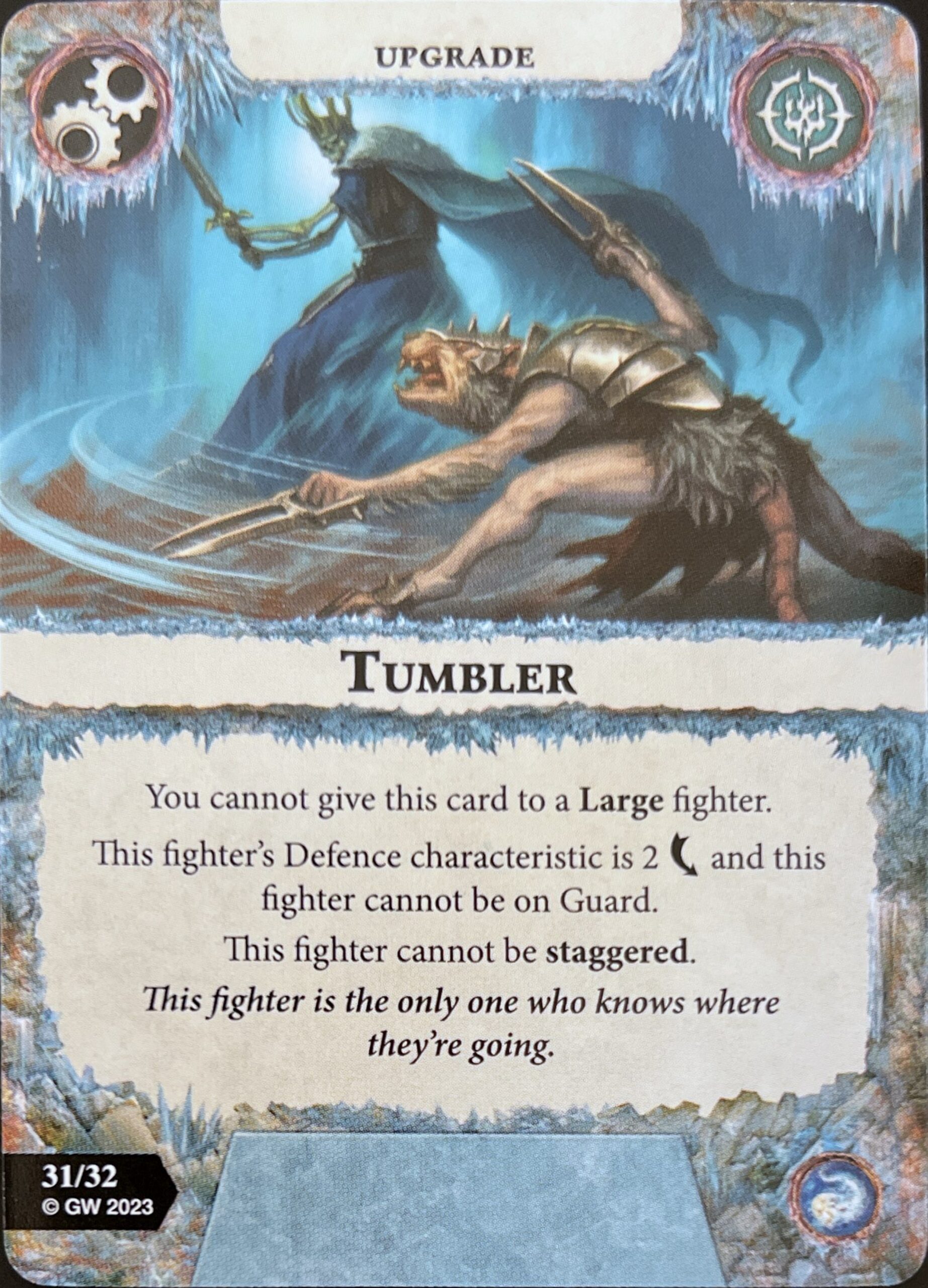
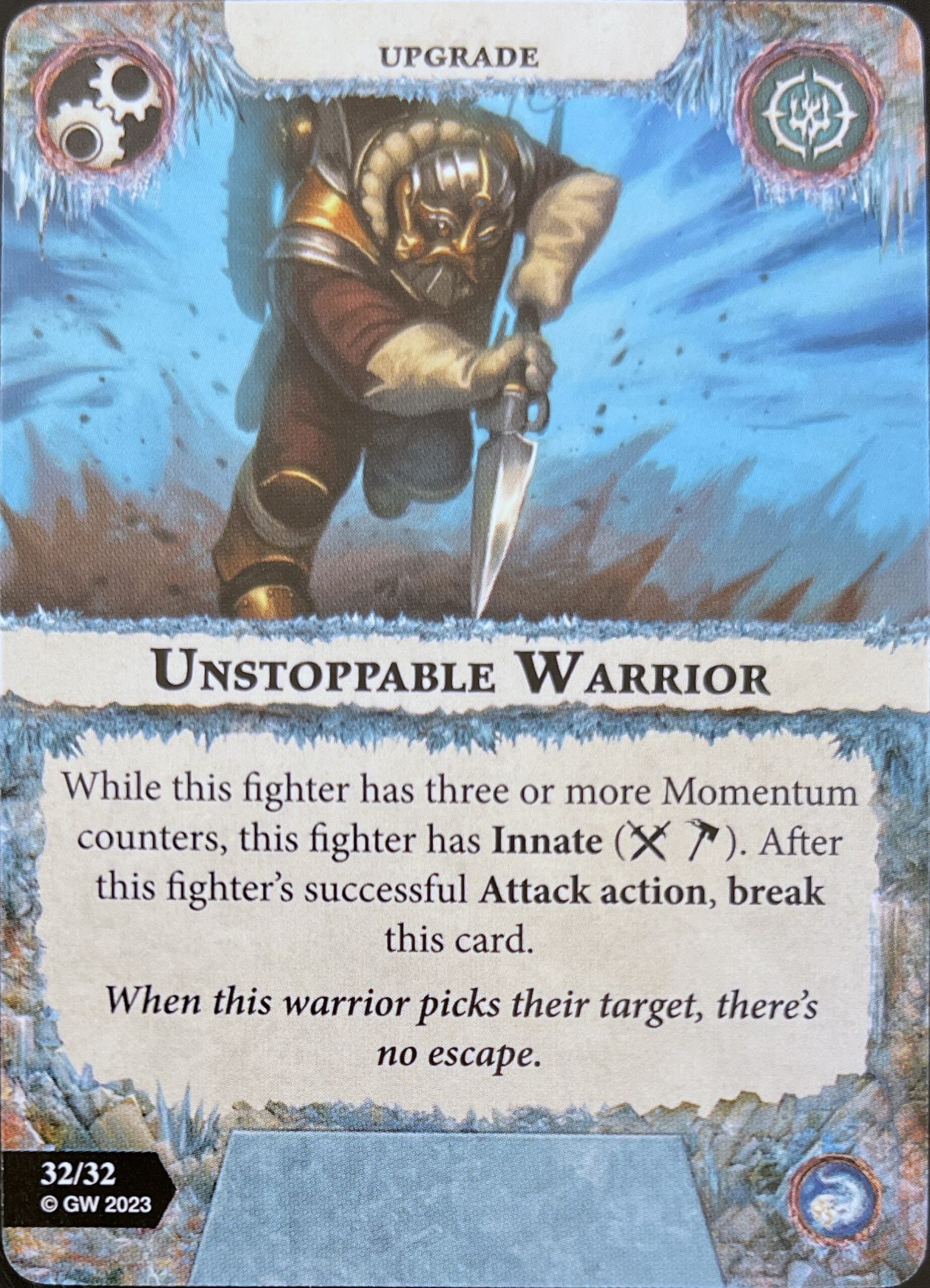
Tumbler cannot be given to a large fighter, sets your Defence characteristic to 2 Dodge, and makes it so you can neither be on guard nor be staggered. The nice thing about this compared to Moving Mark is that you’re not constantly getting pushed around from Impetus resolution, but you have paid for it with a lesser characteristic. Again, it’s not bad if you only roll one die anyway, but not being able to throw 2-Dodge fighters on guard hurts a bit. Interestingly though, this can remove the potential stagger from Impetus. I’m just not quite sure why they were worried about large fighters getting this one, I don’t see anything inherently broken even if Mollog, for example could take this. 2 Dodge just isn’t what it used to be given we live in a world where people are consistently throwing out 3H-level accuracy and/or pinging you to death in the power step. Don’t get me wrong, a defensive buff like this could definitely be a good bit of value, I just don’t like it quite as much as its counterpart in this deck.
Power Ceiling: 2, Consistency: 3, Universality: 2
Our final card in the set is Unstoppable Warrior, which gives the equipped fighter innate sword or hammer while they have 3 or more Momentum counters and breaks after they make a successful attack. While it does take a bit of work to muster up 3 counters, it’s not outrageously difficult, and adding a free success on your attack can be a huge deal for these 2H/3D types, especially if you start factoring in things like Devastating Charge and other damage upgrades. In close matches, there’s always that one attack where it feels like the game hangs in the balance, and this is a really nice way to put your thumb on the scale. However, I do worry that this is a bit dependent on the sequencing of your draws. You generally only want it to come out at the exact moment you have to make that game-defining charge. If it comes out too early, you risk wasting its effectiveness or not having enough counters to pull it off.
Power Ceiling: 3, Consistency: 1, Universality: 2
- Mark: Hurricane Dart
- Aman: Moving Mark
- Zach: Inertial Lance
- George: Moving Mark
Conclusion
Overall, I love the idea of the chaos that this Rivals deck can instigate. I think if you are just looking to play aggro, especially in Nemesis, this seems to have a bit of an edge on Tooth and Claw. Yes, the power cards are not quite as straightforwardly good, but the objectives are, in my opinion, far superior, particularly in the end phases. The Impetus ability adds a bit of a wrinkle as well, but I think mostly from the better, as the extra movement should help you access those early charges more easily while also providing you some control tools with your opponent’s fighters. If TnC was the deck for the “elite” aggro bands and VCT was the deck for horde “aggro,” this one is somewhere in between. As far as pairings go, I am mostly eyeing this for Clawpack, who have suffered heavily in Nemesis to-date as a result of having not found their glove fit yet. There are a number of other warbands that can pull some synergies here, such as Reapers, Fiends, Exiled Dead, but I do worry that many warbands which could play this pairing ultimately have a better one elsewhere. I think, if you’re bringing this to a tournament, you’re often going to be doing so, from a competitive lens, more so to play the deck itself than to play the warband you decided to pair it with.
Anyway, thanks for reading and best of luck on YOUR Path to (momentous) Glory!
____________________
Written by: Mark Breault
Edited by: Aman Khusro
